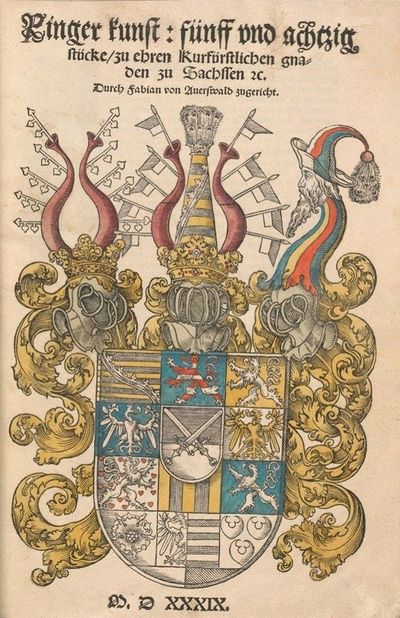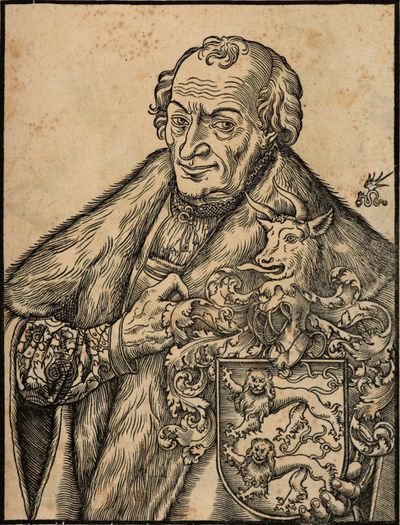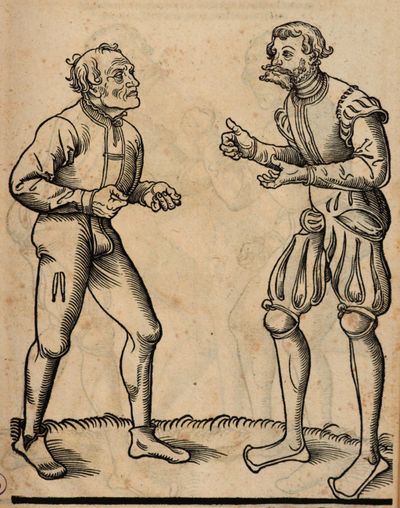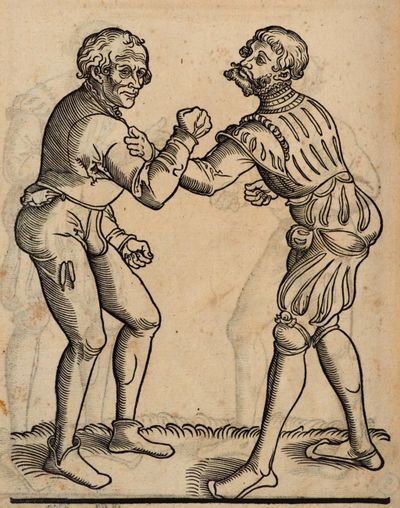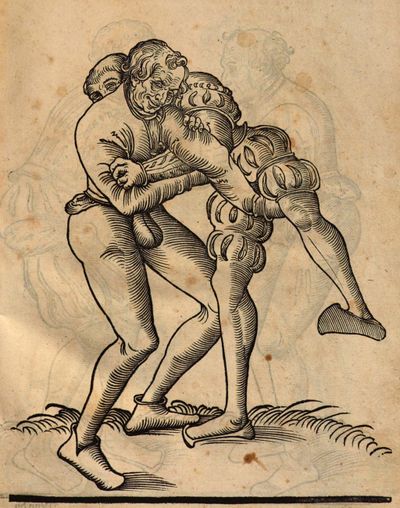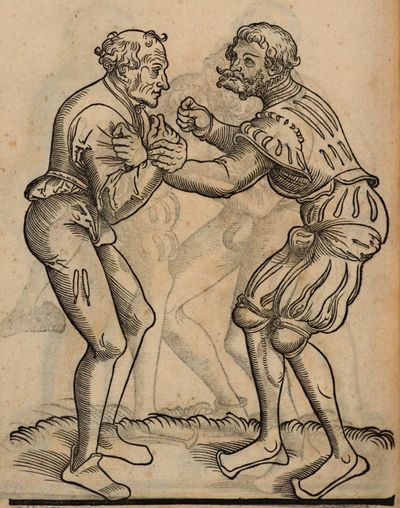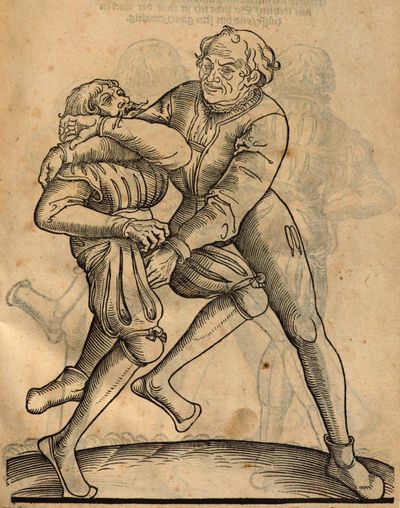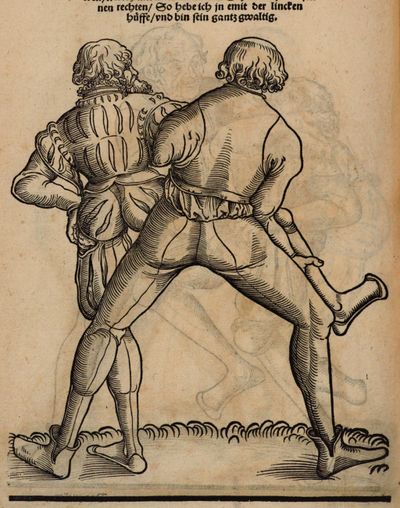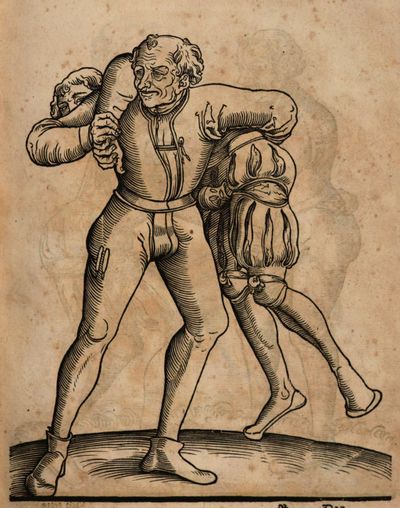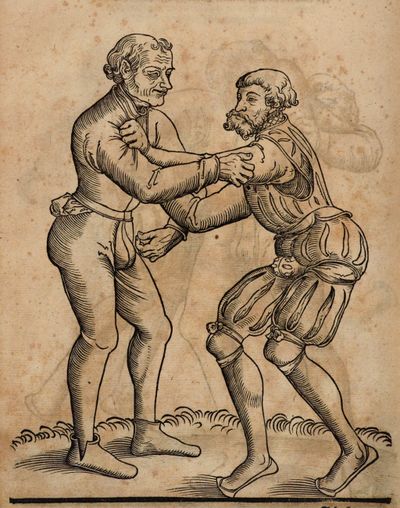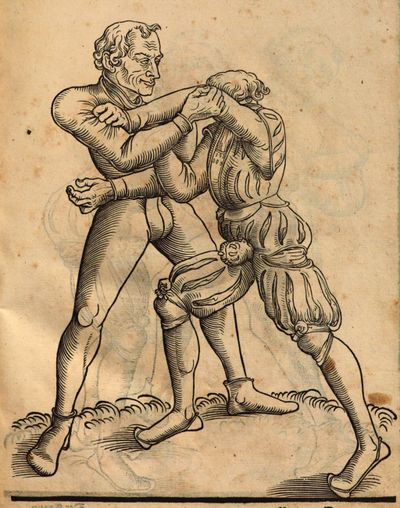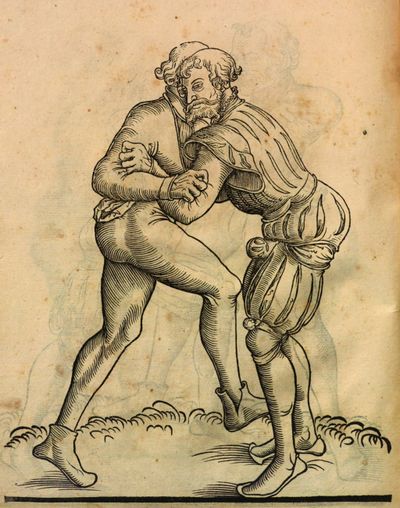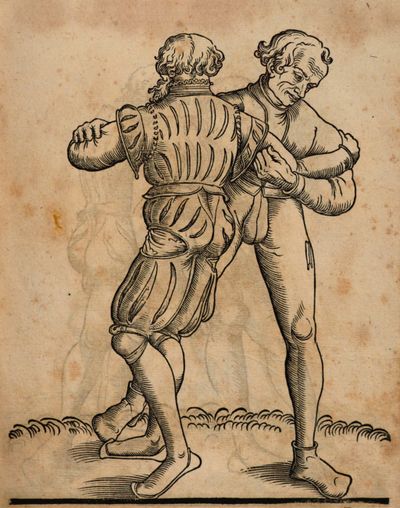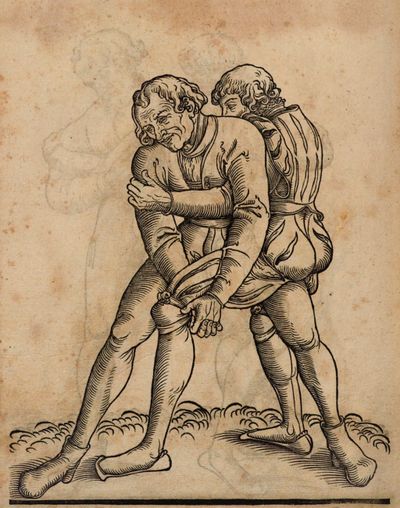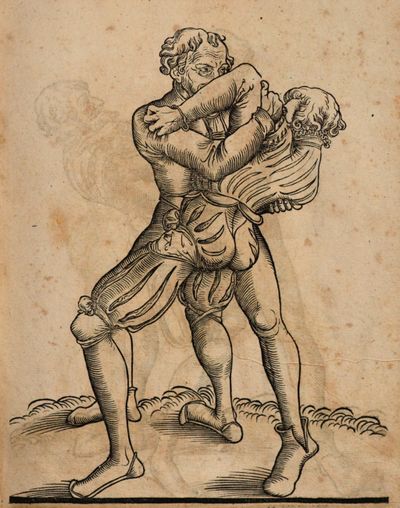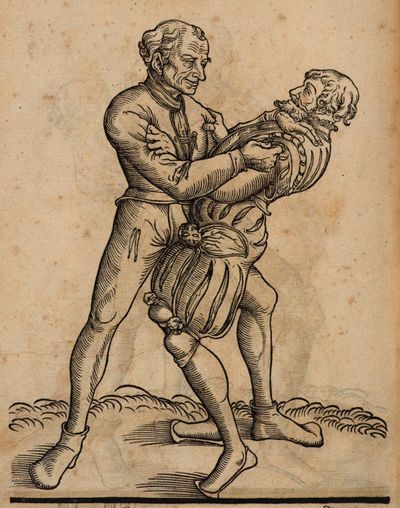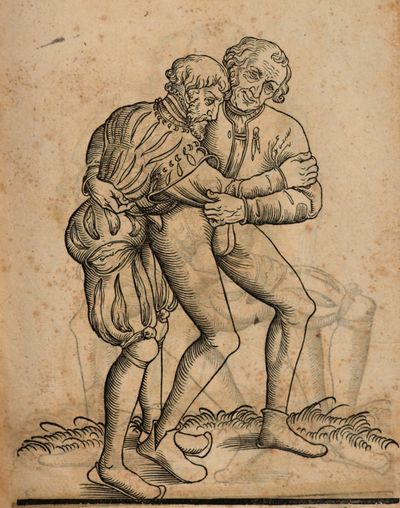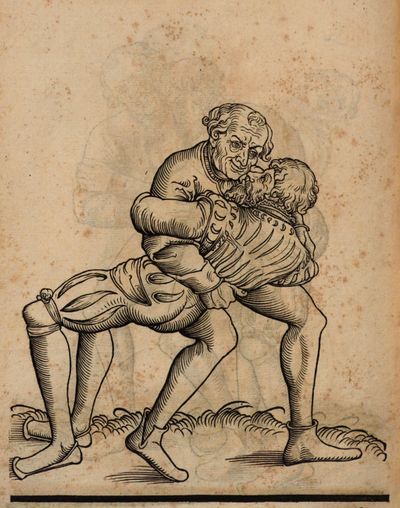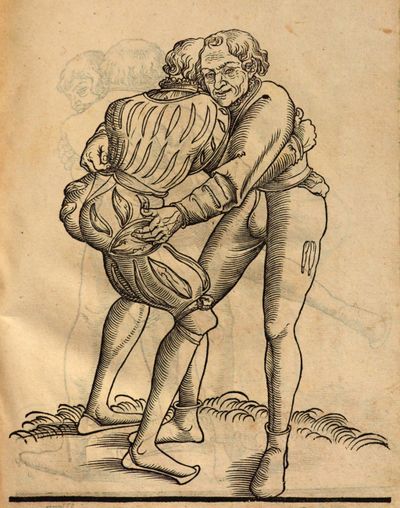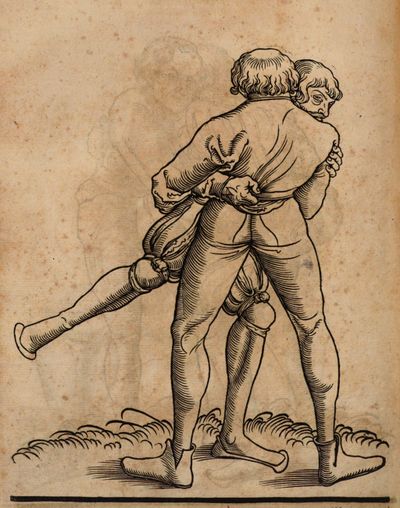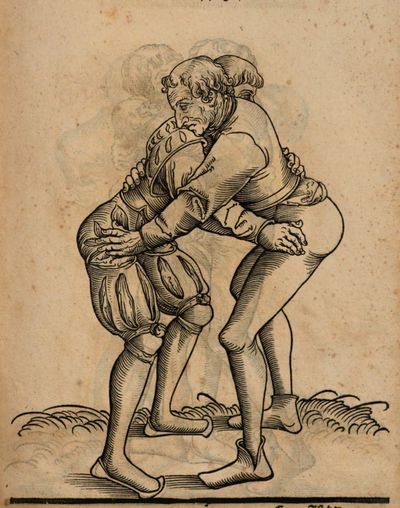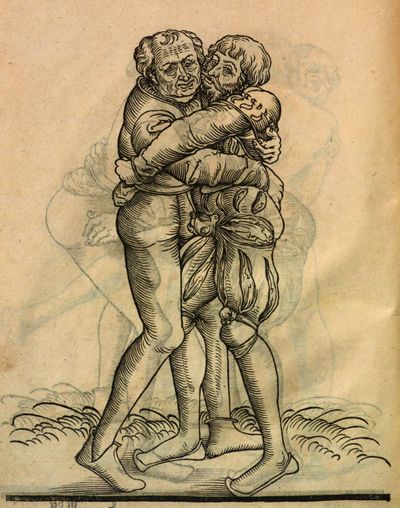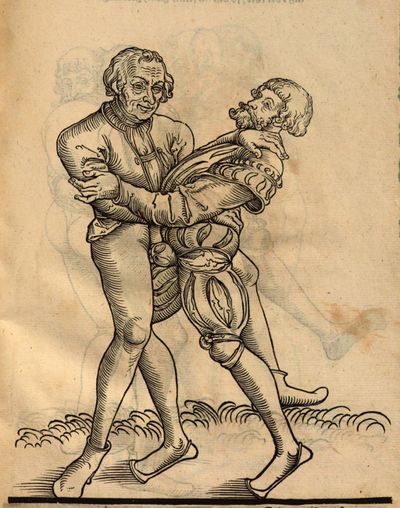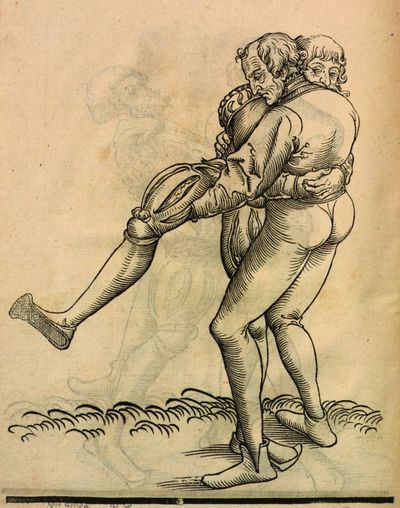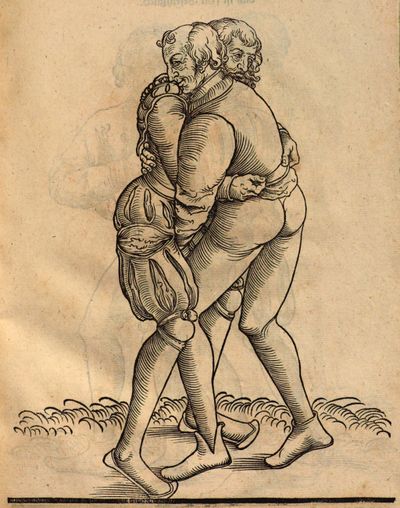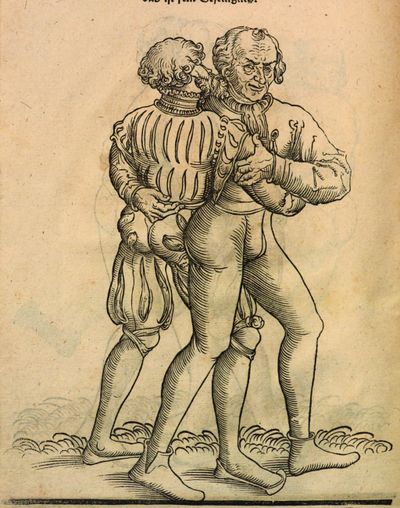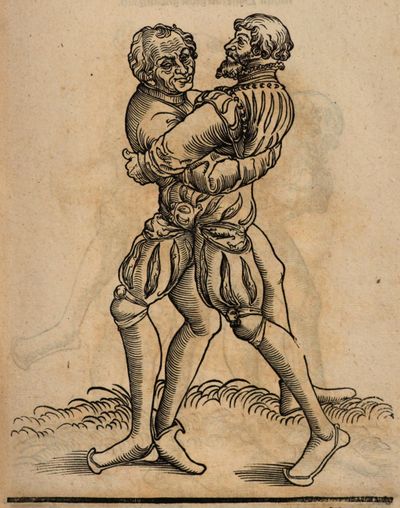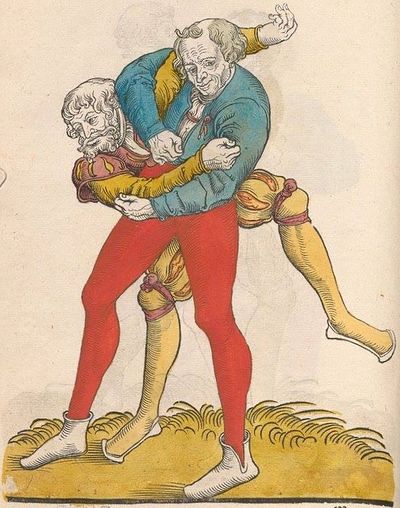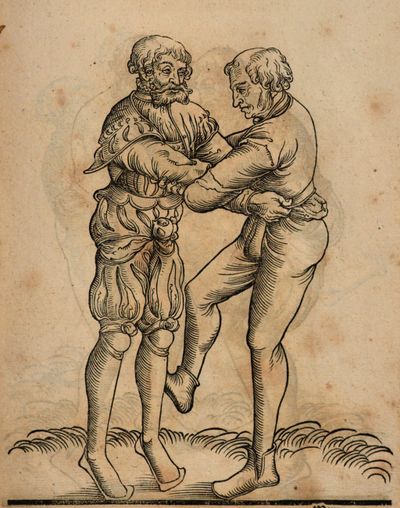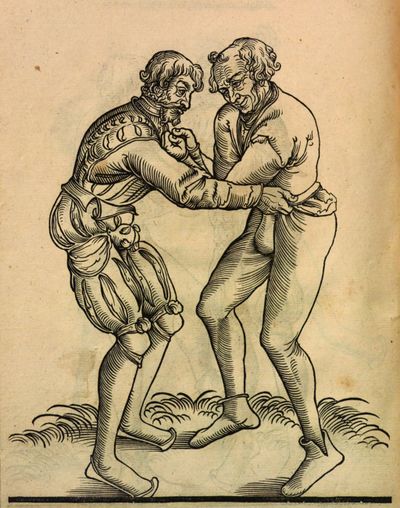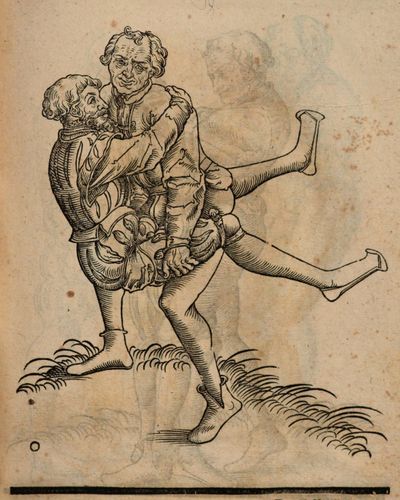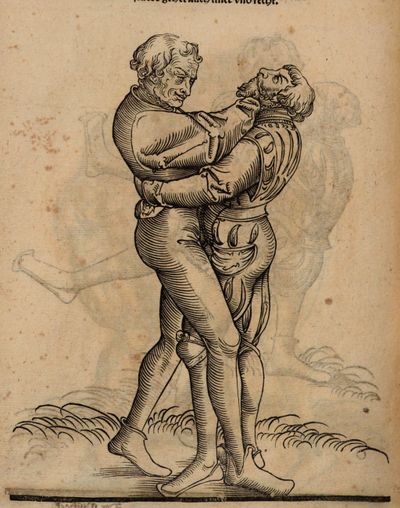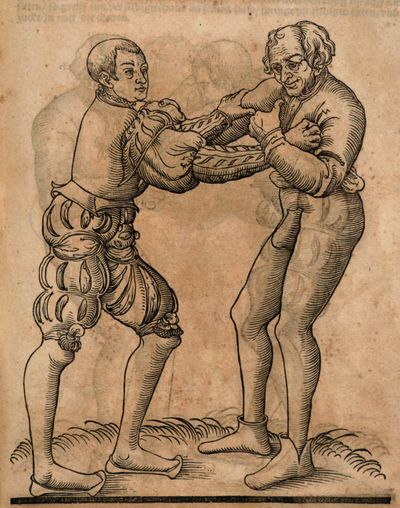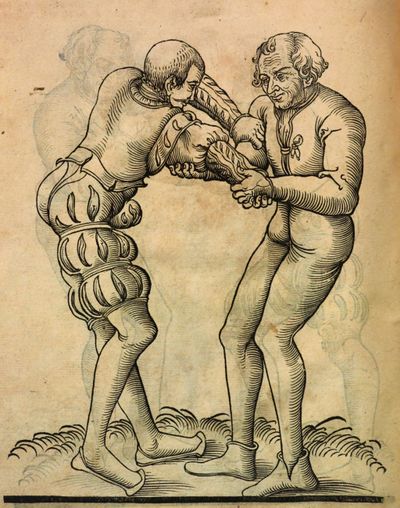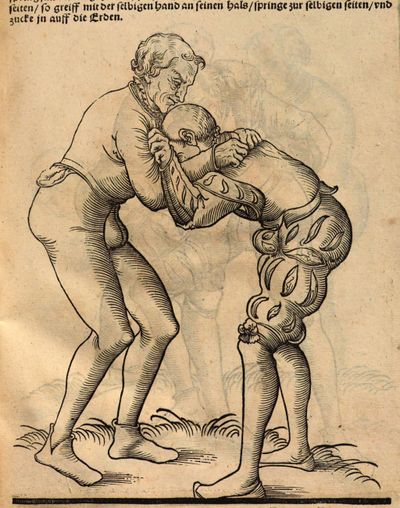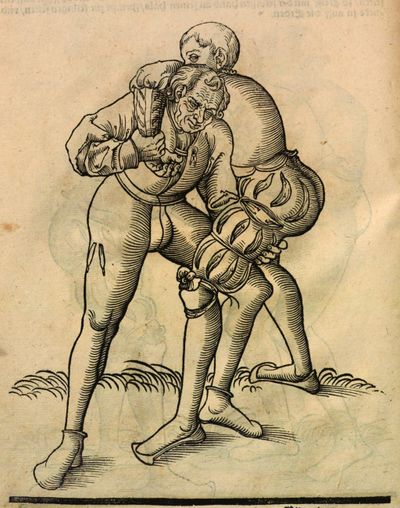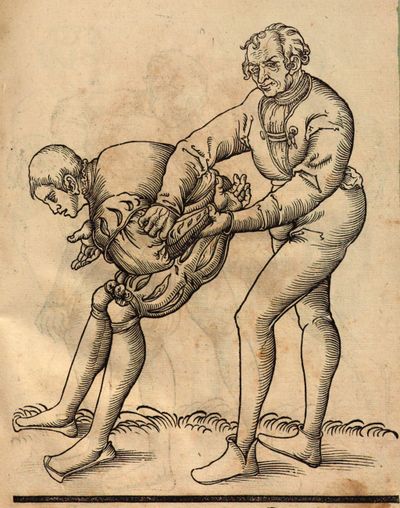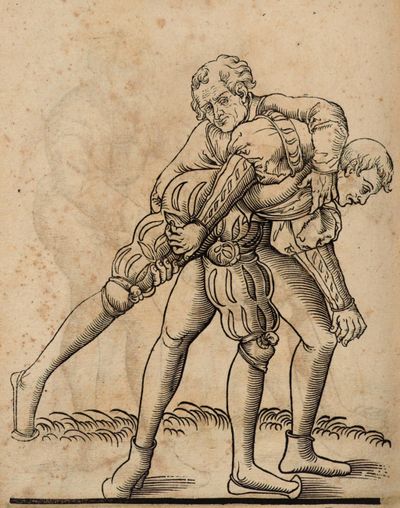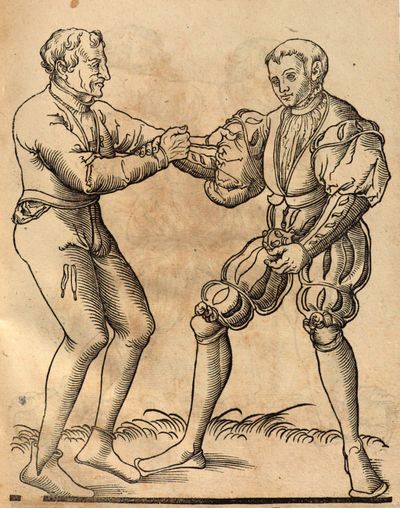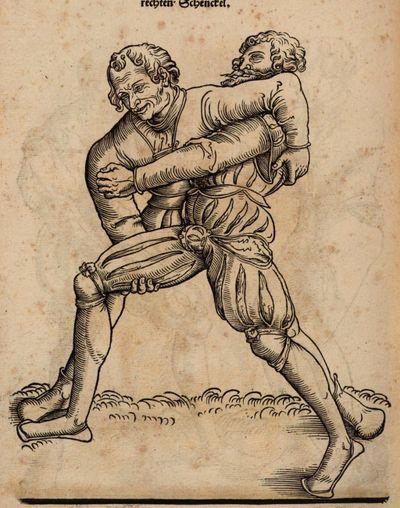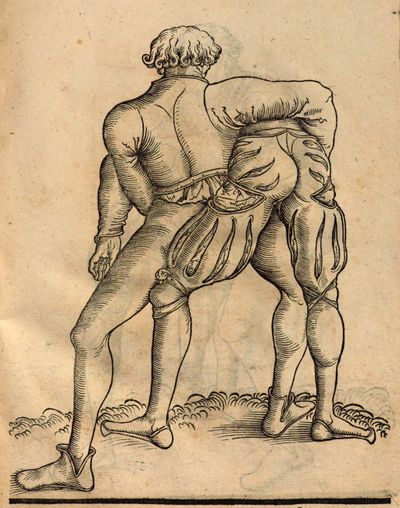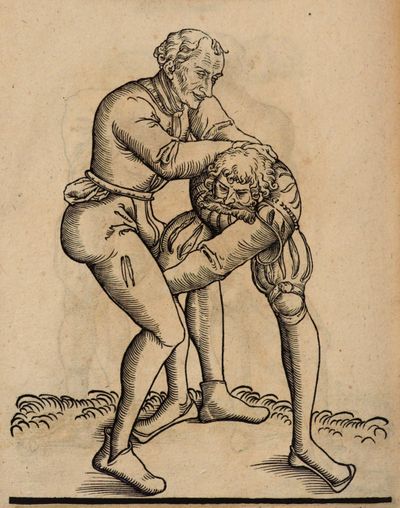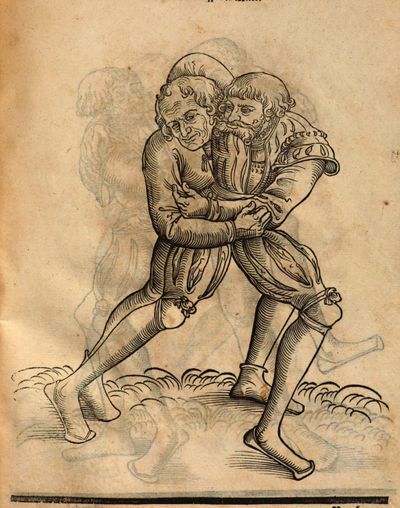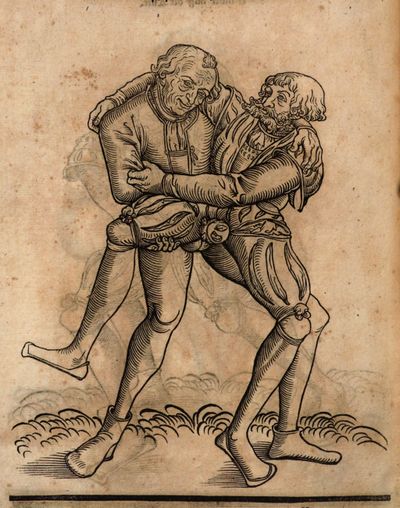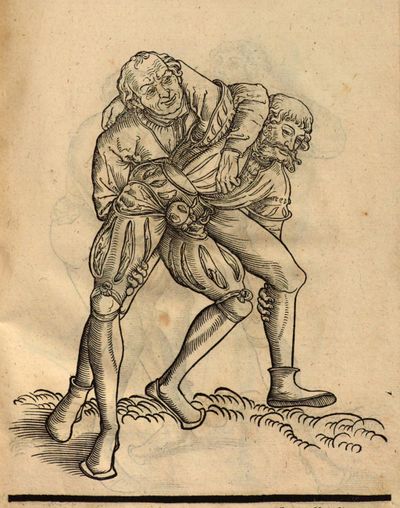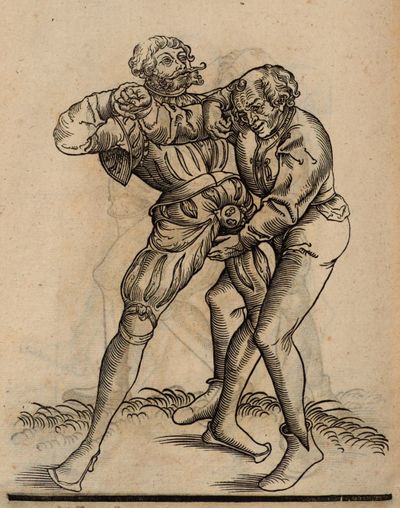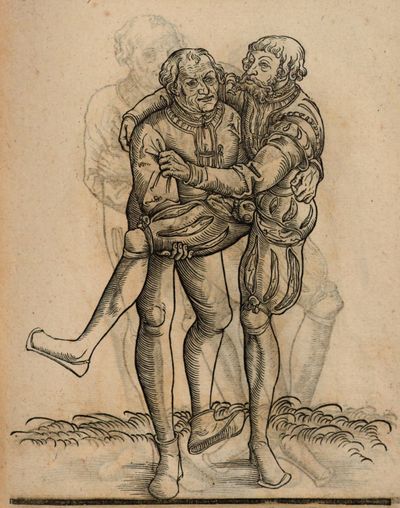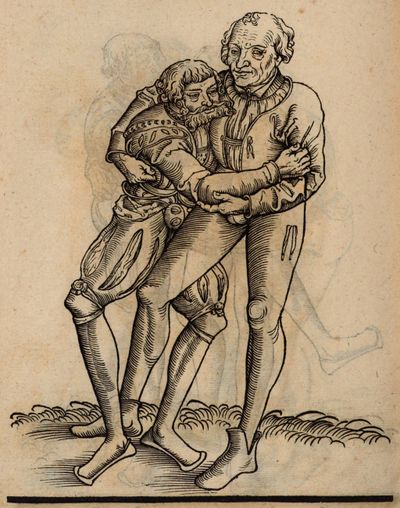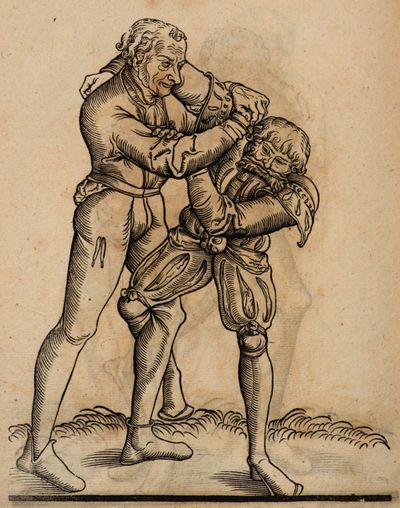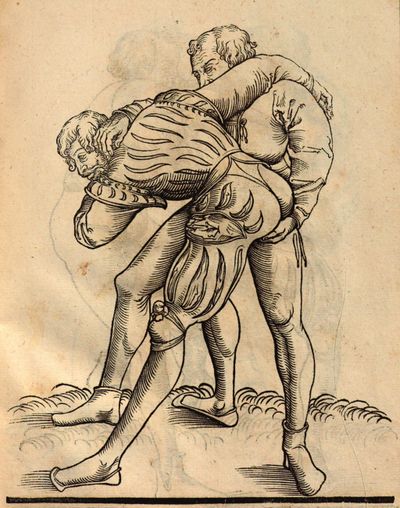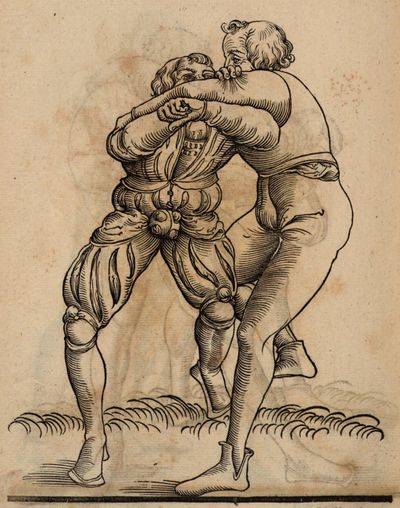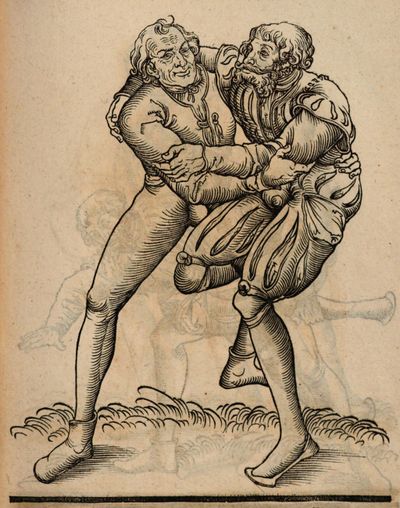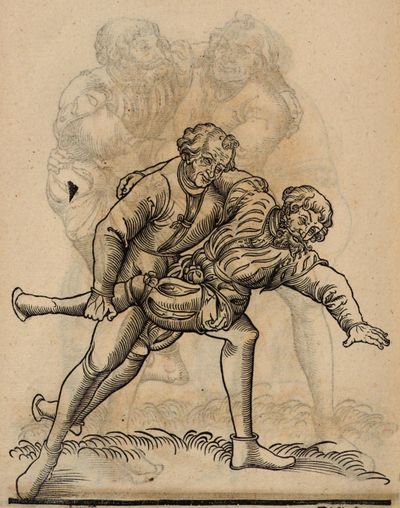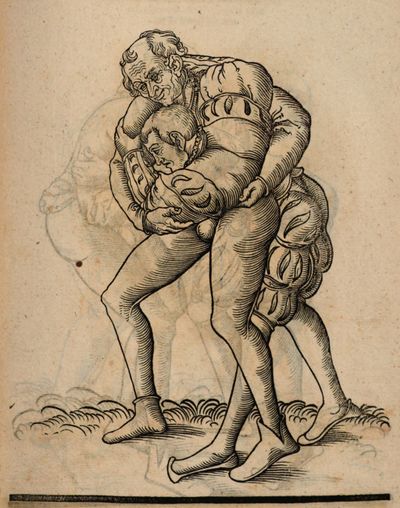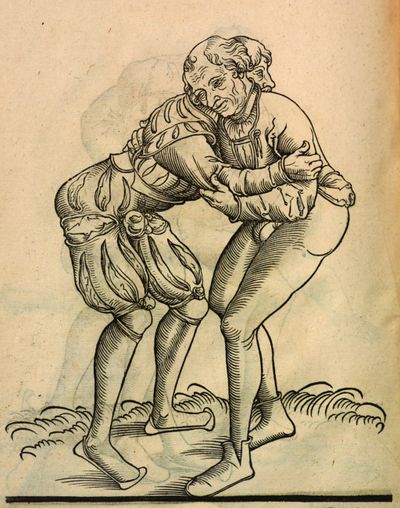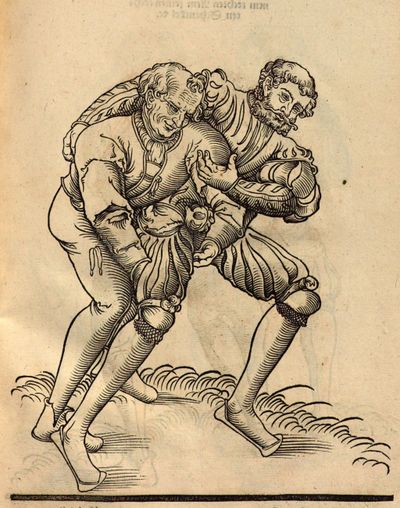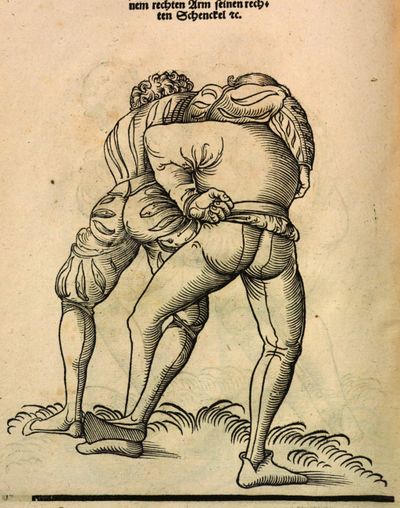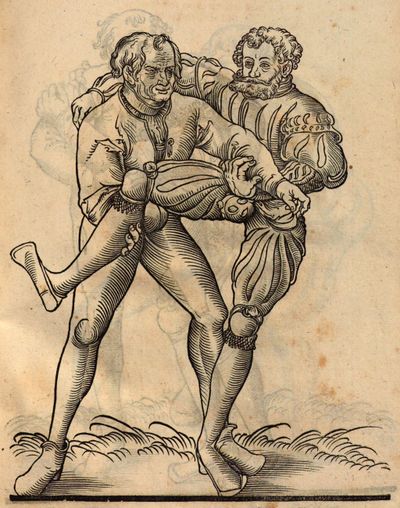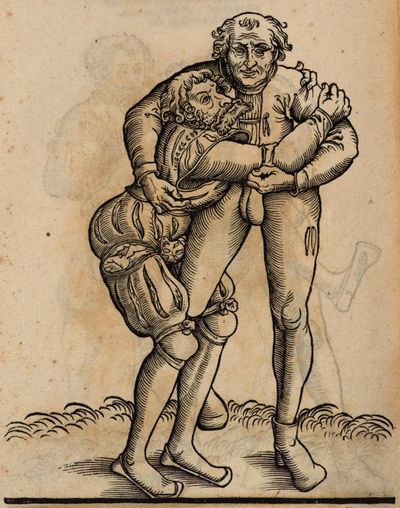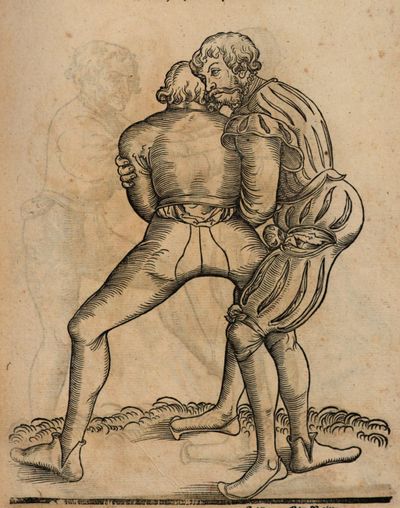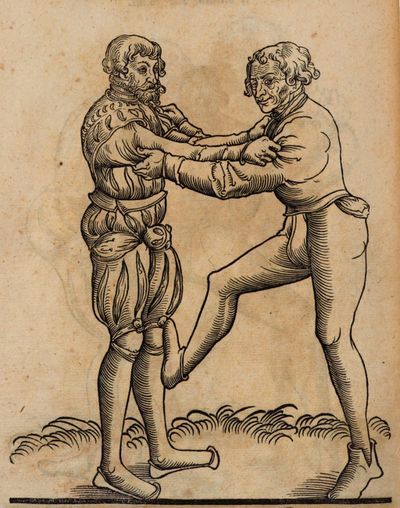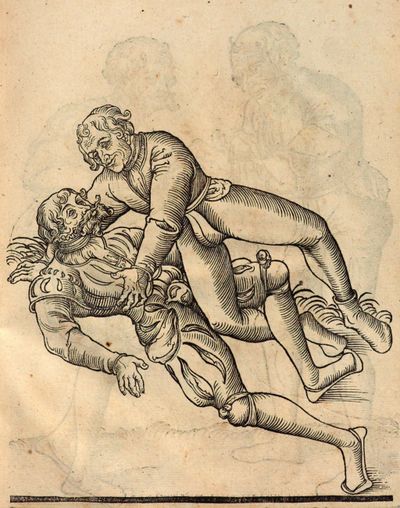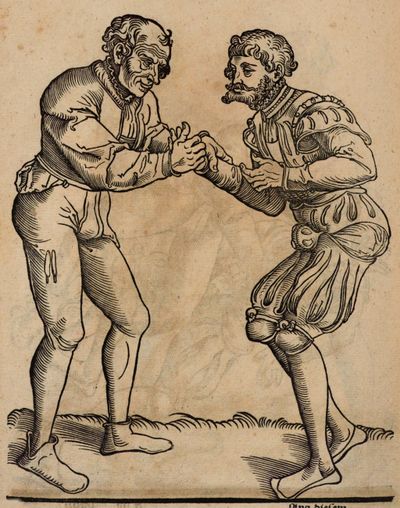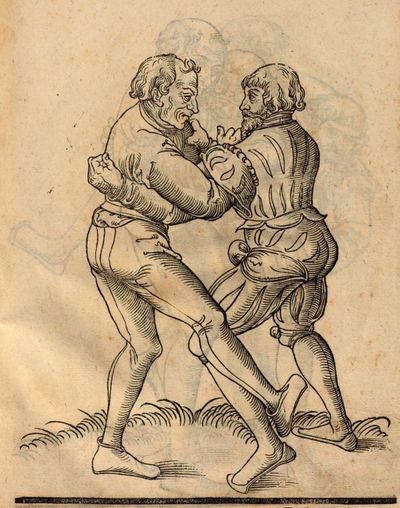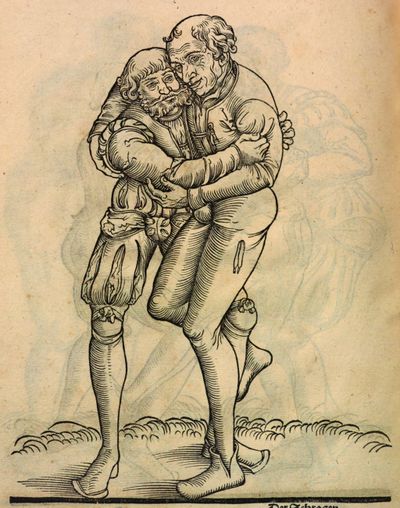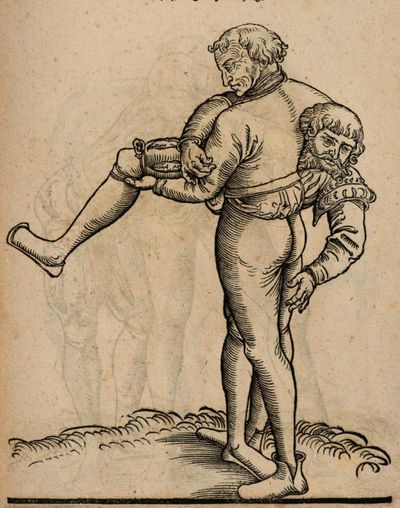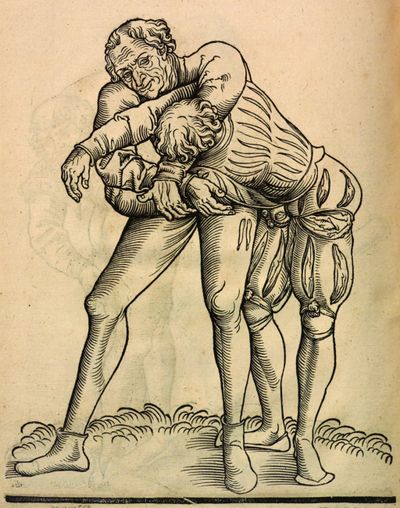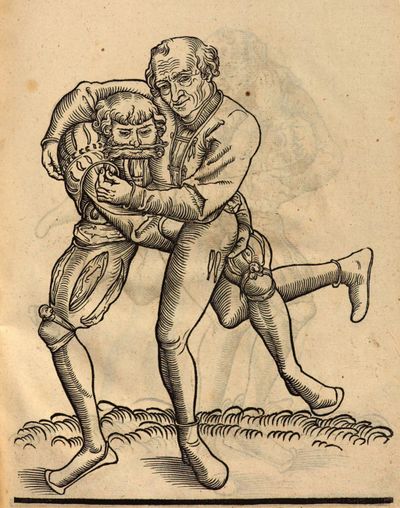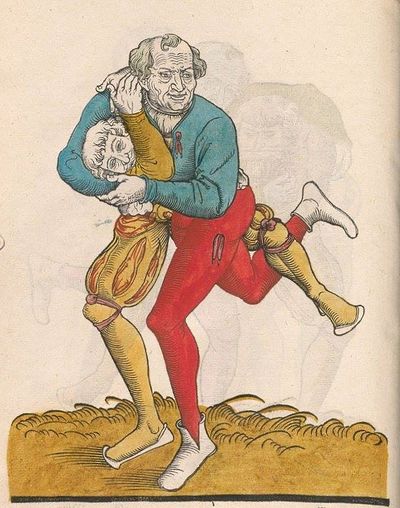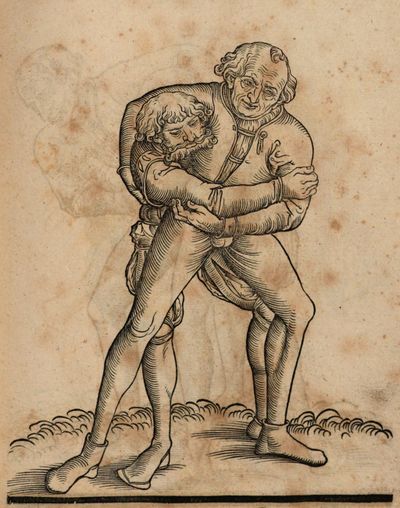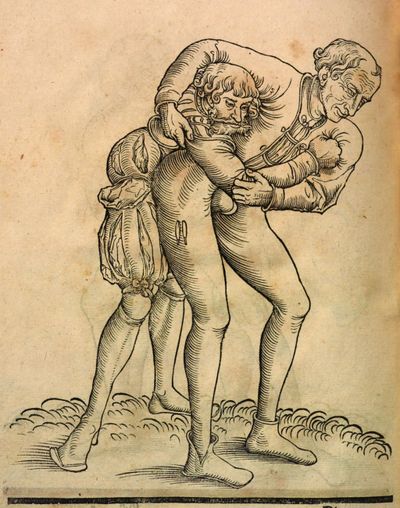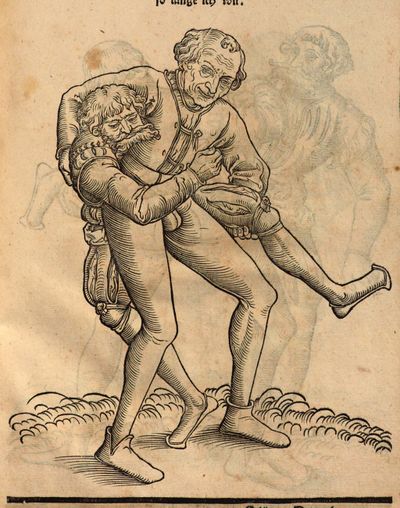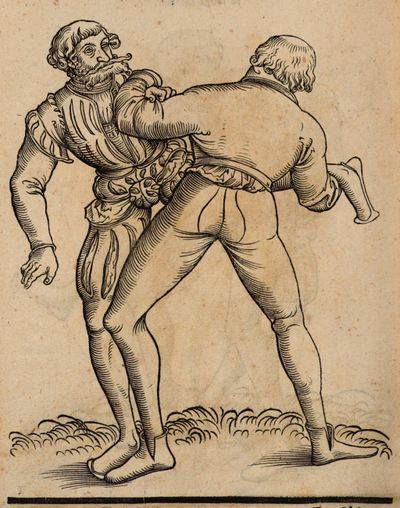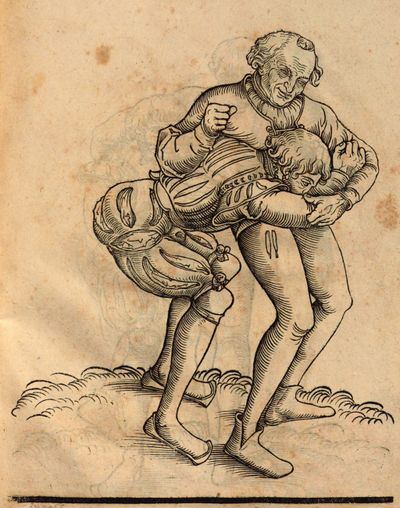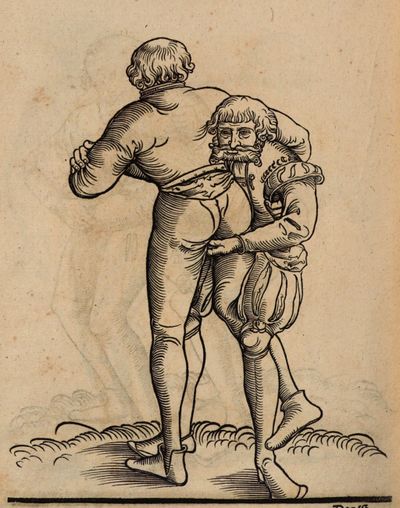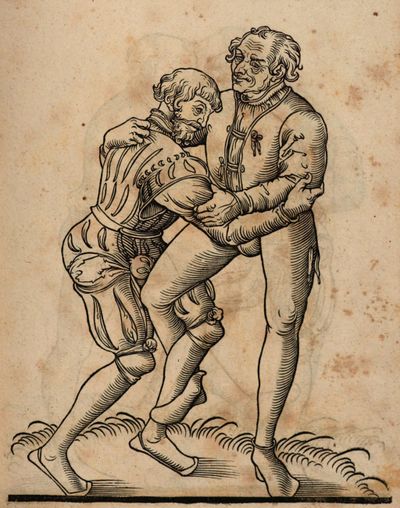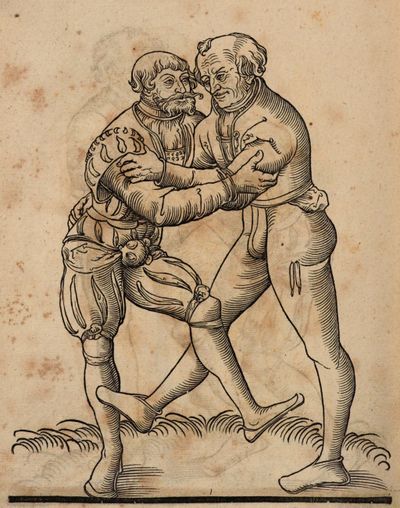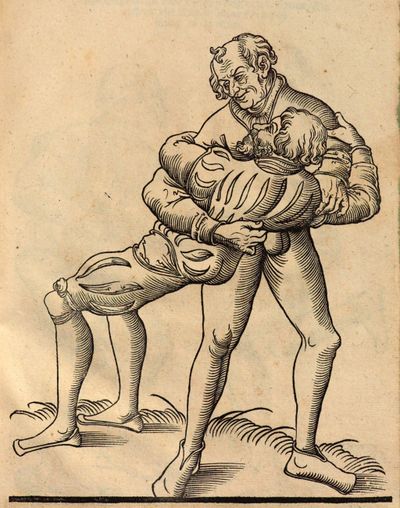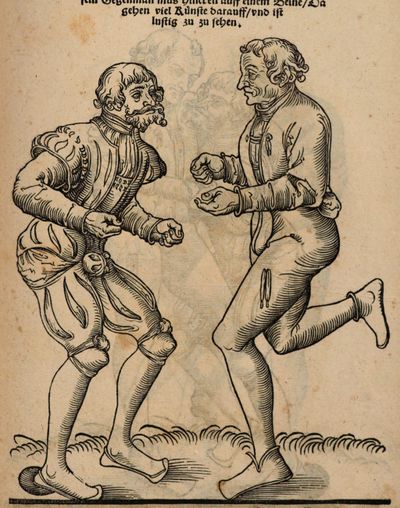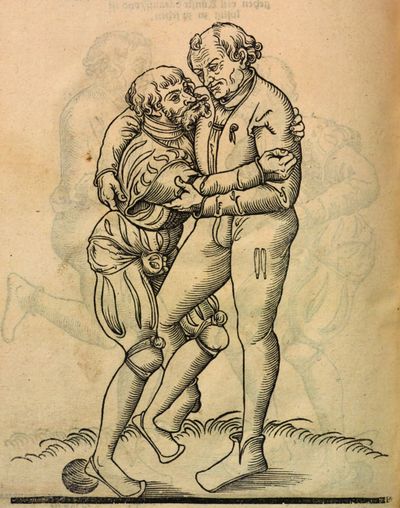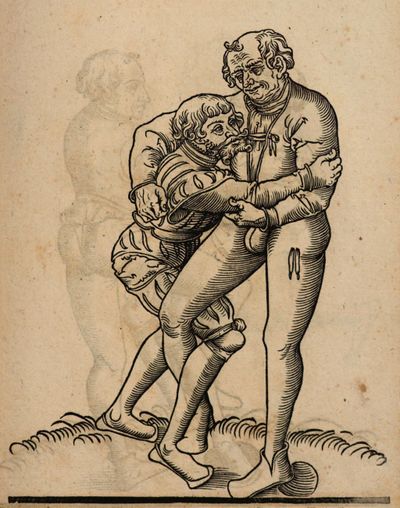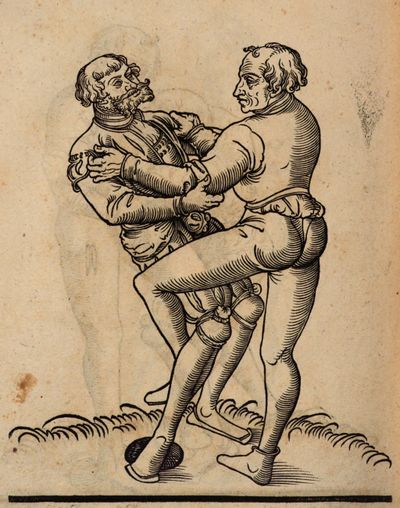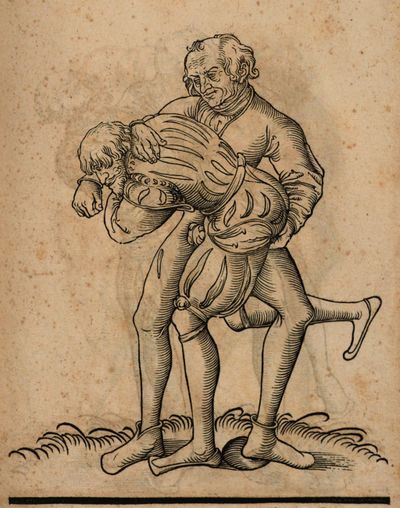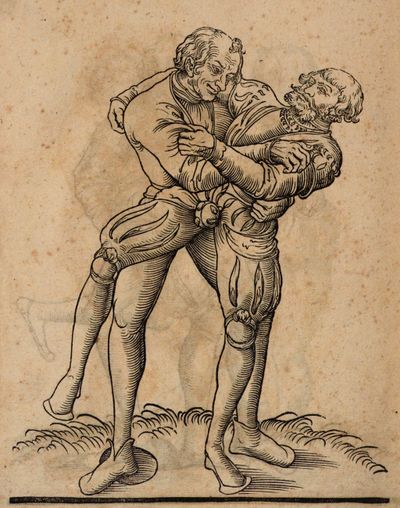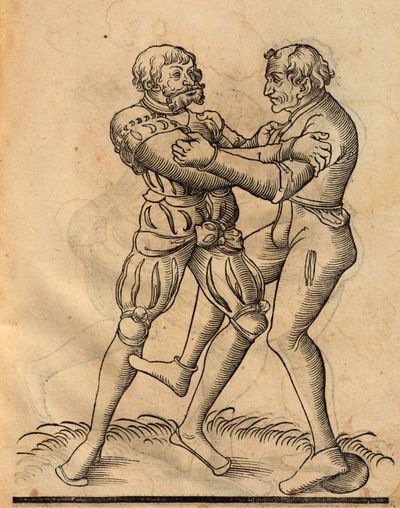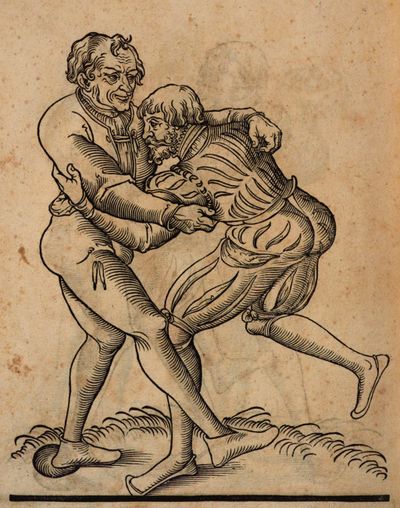|
|
You are not currently logged in. Are you accessing the unsecure (http) portal? Click here to switch to the secure portal. |
Difference between revisions of "Fabian von Auerswald"
| (9 intermediate revisions by the same user not shown) | |||
| Line 1: | Line 1: | ||
{{infobox writer | {{infobox writer | ||
| name = [[name::Fabian von Auerswald]] | | name = [[name::Fabian von Auerswald]] | ||
| − | | image = File: | + | | image = File:Auerswald Portrait.png |
| − | | imagesize = | + | | imagesize = 300px |
| caption = | | caption = | ||
| Line 19: | Line 19: | ||
| education = | | education = | ||
| alma_mater = | | alma_mater = | ||
| − | | patron = John Frederick | + | | patron = [[wikipedia:John Frederick I, Elector of Saxony|Johann Friedrich Ⅰ]] of Saxony |
| period = | | period = | ||
| Line 42: | Line 42: | ||
| below = | | below = | ||
}} | }} | ||
| − | '''Fabian von Auerswald''' (1462 - after 1537) was a 15th-[[century::16th century]] [[nationality::German]] wrestling master. He served as wrestling master to John Frederick, Duke of Saxony, and mentions in his introduction that he instructed the children of the Elector and of members of the court in wrestling. | + | '''Fabian von Auerswald''' (1462 - after 1537) was a 15th-[[century::16th century]] [[nationality::German]] wrestling master. He served as wrestling master to [[wikipedia:John Frederick I, Elector of Saxony|Johann Friedrich Ⅰ]], Duke of Saxony, and mentions in his introduction that he instructed the children of the Elector and of members of the court in wrestling. |
| − | In 1537, Auerswald completed an extensive treatise on [[grappling]], which was later illustrated by [[Lucas Cranach the Elder]] and published posthumously in 1539 by [[Hans Lufft]] under the title ''[[Ringer Kunst (Fabian von Auerswald)|Ringer kunst: funf und Achtzig Stücke]]'' ("The Art of Wrestling: Eighty-Five | + | In 1537, Auerswald completed an extensive treatise on [[grappling]], which was later illustrated by [[Lucas Cranach the Elder]] and published posthumously in 1539 by [[Hans Lufft]] under the title ''[[Ringer Kunst (Fabian von Auerswald)|Ringer kunst: funf und Achtzig Stücke]]'' ("The Art of Wrestling: Eighty-Five Pieces"). One of the earliest printed treatises on wrestling, the book includes lucid descriptions and detailed illustrations of all of its 85 pieces, including one of only two known descriptions of the game called "wrestling in the pit". This treatise saw relatively wide circulation, and at least one wrestling master went as far as to commission a careful manuscript copy ([[Ringer Kunst (2º Col.MS.Philos.62)|2º Col.MS.Philos.62]]), to which he added his own annotations on many of the techniques. Auerswald's work also formed the foundation for [[Paulus Hector Mair]]'s treatment of the subject in his own compilation fencing manuscripts of the 1540s. |
== Treatise == | == Treatise == | ||
| Line 54: | Line 54: | ||
{| class="master" | {| class="master" | ||
|- | |- | ||
| − | ! <p> | + | ! <p>Illustrations<br/></p> |
! <p>{{rating|C|Draft Translation (Archetype)}}<br/>by [[James Klock]]</p> | ! <p>{{rating|C|Draft Translation (Archetype)}}<br/>by [[James Klock]]</p> | ||
| − | ! <p>[[Ringer Kunst (Fabian von Auerswald)|Archetype | + | ! <p>[[Ringer Kunst (Fabian von Auerswald)|Archetype Version]] (1539){{edit index|Ringer Kunst (Fabian von Auerswald) 1539.pdf}}<br/>Transcribed by [[Keith P. Myers]]</p> |
| − | ! <p>[[Ringer Kunst (2º Col.MS.Philos.62)|Göttingen | + | ! <p>[[Ringer Kunst (2º Col.MS.Philos.62)|Göttingen Version]] (after 1539){{edit index|Ringer Kunst (2º Col.MS.Philos.62)}}<br/>Transcribed by [[Thore Wilkens]]</p> |
|- | |- | ||
| Line 98: | Line 98: | ||
{| class="master" | {| class="master" | ||
|- | |- | ||
| − | ! <p> | + | ! <p>Illustrations<br/></p> |
! <p>{{rating|C|Draft Translation (Archetype)}}<br/>by [[James Klock]]</p> | ! <p>{{rating|C|Draft Translation (Archetype)}}<br/>by [[James Klock]]</p> | ||
| − | ! <p>[[Ringer Kunst (Fabian von Auerswald)|Archetype | + | ! <p>[[Ringer Kunst (Fabian von Auerswald)|Archetype Version]] (1539){{edit index|Ringer Kunst (Fabian von Auerswald) 1539.pdf}}<br/>Transcribed by [[Keith P. Myers]] and [[Ingulf Kohlweiss]]</p> |
| − | ! <p>[[Ringer Kunst (2º Col.MS.Philos.62)|Göttingen | + | ! <p>[[Ringer Kunst (2º Col.MS.Philos.62)|Göttingen Version]] (after 1539){{edit index|Ringer Kunst (2º Col.MS.Philos.62)}}<br/>Transcribed by [[Thore Wilkens]]</p> |
|- | |- | ||
| Line 1,032: | Line 1,032: | ||
{| class="master" | {| class="master" | ||
|- | |- | ||
| − | ! <p> | + | ! <p>Illustrations<br/></p> |
! <p>{{rating|C|Draft Translation (Archetype)}}<br/>by [[James Klock]]</p> | ! <p>{{rating|C|Draft Translation (Archetype)}}<br/>by [[James Klock]]</p> | ||
| − | ! <p>[[Ringer Kunst (Fabian von Auerswald)|Archetype | + | ! <p>[[Ringer Kunst (Fabian von Auerswald)|Archetype Version]] (1539){{edit index|Ringer Kunst (Fabian von Auerswald) 1539.pdf}}<br/>Transcribed by [[Ingulf Kohlweiss]]</p> |
| − | ! <p>[[Ringer Kunst (2º Col.MS.Philos.62)|Göttingen | + | ! <p>[[Ringer Kunst (2º Col.MS.Philos.62)|Göttingen Version]] (after 1539){{edit index|Ringer Kunst (2º Col.MS.Philos.62)}}<br/>Transcription open for editing</p> |
|- | |- | ||
| [[File:Auerswald 84.jpg|400px|center|border]] | | [[File:Auerswald 84.jpg|400px|center|border]] | ||
| Line 1,101: | Line 1,101: | ||
<section begin="sourcebox"/>{{sourcebox header}} | <section begin="sourcebox"/>{{sourcebox header}} | ||
{{sourcebox | {{sourcebox | ||
| − | | work = | + | | work = Illustrations |
| authors = [[Lucas Cranach the Elder]] | | authors = [[Lucas Cranach the Elder]] | ||
| source link = http://data.onb.ac.at/ABO/%2BZ184164906 | | source link = http://data.onb.ac.at/ABO/%2BZ184164906 | ||
| Line 1,109: | Line 1,109: | ||
{{sourcebox | {{sourcebox | ||
| work = Translation | | work = Translation | ||
| − | | authors = [[James Klock]] | + | | authors = [[translator::James Klock]] |
| source link = http://www.klocktower.org/ringen/auerswald/AuerswaldTranslation.pdf | | source link = http://www.klocktower.org/ringen/auerswald/AuerswaldTranslation.pdf | ||
| source title= The Klocktower | | source title= The Klocktower | ||
| Line 1,133: | Line 1,133: | ||
== Additional Resources == | == Additional Resources == | ||
| − | + | {{bibliography}} | |
| − | |||
| − | |||
== References == | == References == | ||
Latest revision as of 23:09, 2 November 2023
| Fabian von Auerswald | |
|---|---|
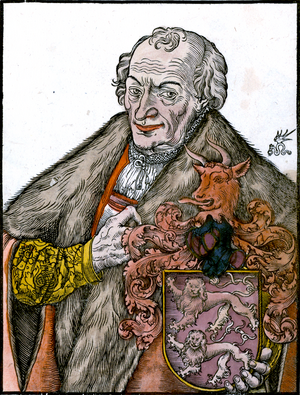 | |
| Born | 1462 |
| Died | ca. 1537 |
| Occupation | Wrestling master |
| Patron | Johann Friedrich Ⅰ of Saxony |
| Genres | Wrestling manual |
| Language | Early New High German |
| Notable work(s) | Ringer Kunst (1539) |
| Manuscript(s) | 2° Col. MS Philos. 62 (ca. 1539) |
| Concordance by | Michael Chidester |
Fabian von Auerswald (1462 - after 1537) was a 15th-16th century German wrestling master. He served as wrestling master to Johann Friedrich Ⅰ, Duke of Saxony, and mentions in his introduction that he instructed the children of the Elector and of members of the court in wrestling.
In 1537, Auerswald completed an extensive treatise on grappling, which was later illustrated by Lucas Cranach the Elder and published posthumously in 1539 by Hans Lufft under the title Ringer kunst: funf und Achtzig Stücke ("The Art of Wrestling: Eighty-Five Pieces"). One of the earliest printed treatises on wrestling, the book includes lucid descriptions and detailed illustrations of all of its 85 pieces, including one of only two known descriptions of the game called "wrestling in the pit". This treatise saw relatively wide circulation, and at least one wrestling master went as far as to commission a careful manuscript copy (2º Col.MS.Philos.62), to which he added his own annotations on many of the techniques. Auerswald's work also formed the foundation for Paulus Hector Mair's treatment of the subject in his own compilation fencing manuscripts of the 1540s.
Contents
Treatise
Illustrations |
Archetype Version (1539) |
Göttingen Version (after 1539) | |
|---|---|---|---|
The Art of Wrestling: 85 pieces to the honorable and gracious Electors of Saxony, &c. by Fabian von Auerswald. 1539. |
[1] Ringer kunst: fünff und achtzig stücke, zu ehren Kurfürstlichen gnaden zu Sachssen &c. Durch Fabian von Auerswald zugericht. M. D XXXIX. |
[01r] Ringer künst: fünff vnd achtzigk stucke zue ehrenn churfurstlichenn gnaden zue sachsen &c. Durch Fabian von Auerswaldt zugerichtet. M. D. XXXIX | |
Forward. In hope that it should please the honor of the illuminated and highborn sovereign and lord, Lord John Frederick, Elector of Saxony, my gracious Lord, have I, Fabian von Auerswald taken upon myself, the honorable and noble art, and the knightly virtue of wrestling which I have, by the authority of the wise and illuminated, highborn sovereign and lord, Lord Ernest, Elector of Saxony, blessed and Christian in his thought such as from the same widely-famed wrestling masters, as have instructed the Elector and the young men of my gracious Lords, the Electors' sons, and other sovereigns Counts and Lords who have from those noble men and myself learned. And I have, in the same knightly and noble art, instructed and drawn together, and in an artful and systematic report and text, brought into print which is also the righteous art of wrestling, and previously the figure of it never came. Which high report I also beg my gracious sovereign and lord with God's help I have been bestowed, and from which many honorable and good people may profit, honorably and with piety, to honorable and knightly causes it will be brought to light. And it is my hope, my humble and friendly prayer that when any so high or low in station, should my work and labor encounter or acquire, That he would take from me the same gracious friendship and aid, and keep myself and my children in his aid, Now that I am old man well beyond my days, For I was born in 1462, And have this work in the Year of Our Lord 1537, in Wittenberg, completed. |
[3] Vorrede. Zu ehren und unterthenigem gefallen, dem Durchleuchtigsten und Dochgebornen Fersten und Herrn, Herrn Johansen Friderichen, Hertzogen zu Sachssen, und Kurfuersten &c. meinem gnedigsten Herrn, Habe ich Fabian von Auerswald, fur mich genomen, die alte Ehrliche und Adeliche kunst, des Ritterschimpffs, des Ringens, wie ich bey Regiorung, weiland des durchleuchtigsten Hochgebornen Fuersten und Herrn, Herrn Ernsten, Hertzogen zu Sachssen, und Kurfuersten, seliger und Christlicher gedechtnis, solchs von der selben weitberuemten Ringmeistern, die dazumal bey seiner Kurfuerstlichen geraden zu Hofe gewesen, und die Jugent, als meine gnedigste und gnedige Herrn, seiner Kurfuerstlichen gnaden Soene, und andere fuersten, Grauen und Herrn, und die vom Adel und mich gelernet, und inn solchen Ritterlichen und Adelichen kuensten, unterweiset, zusamen gezogen, und mit artigem und lustigem Gemelde, und schrifften, inn Druck bringen lassen, welches auch die rechte art und kunst des Ringens ist, und vormals der gestalt, nie an tag komen, Welches ich auff hochgemelts meins gnedigsten Fuersten und Herrn begern, mit verleihung Goettlicher huelffe volendet, Und vielen ehrlichen und guten Leuten zu nutz, ehren und fromen, zu Ernstlichen und Ritterschimpfflichen sachen, habe woellen ans liecht bringen. Und ist mein unterthenigs, dienstlichs und freundlichs bitten, an wen, von hohen oder nidern Stand, solche meine arbeit, muehe und vleis, komen und gelangen wird, Er woelle die selbig von mir zu gnaden, gunsten und freundschafft annemen, und mich und meine Kinder im besolhen sein lassen, Sonderlich dieweil ich nu mehr ein alter vorlebter Man, Denn ich bin im vierzehenhundert und zwey und sechzigsten jar geborn, Und hab solche meine arbeit, nach Christi unsers lieben Herrn gehurt, 1537. jare zu Witemberg verfertiget. |
[02r] Vorrehde: Zue Ehren vnd vnterthenigem Gefallen Dem durchlauchtigsten vnnd hochgebornen fursten vnd hern hern Johansen Friederichen hertzog zue Sachsen vnnd khurfursten meinem gnedigsten hern habe ich Fabian von Auerswald fur mich genommen die alte ehrliche vnd adeliche kunst des ritterschimpfs des ringens wie ich beÿ regierung weiland des durchlauchtigsten hochgebornen fursten vnd hern, hern Ernsten hertzogen zue sachsen vnd khurfursten, seliger vnd christlichen gedachtnus, solches von derselben weitberumbten ringmeistern, die dazumal beÿ sn. khurfl. G. zue hofe gewesen vnd die jugent als meine gnedigste vnd gendige hern, s. khurf., G. sohne vnd anderen fursten grafenn vnd heren vnd die von adel vnd mich gernet[!] vnd in solchen ritterlichen vnd adelichen kunsten vnterweiset, zuesamen gezogen vnd mit artigen vnd lustigem gemälde vnd schriften in druck bringen lassen, welche auch die rechte art vnd kunst des ringens ist vnd vormals dergestalt nie an tag komen welches ich auf hochermelts meines g. f. vnd hern begern, mit verleihung gotlichen hulffe vollendet, vnd vielen ehrlichen vnd guten leuten zu nutz, ehren vnd fromen, zu ernstlichen vnd ritterschimpflichen sachen habe wollen ans licht bringen auch ist mein vnterthenigster dienst vnd freundliches bitten an wen von hohen oder niedern stand solche meine arbeit muhe vnd fleiß komen vnd gelangen wird er wolle dieselbig von mir zu gnaden gunsten vnd freundschaft annehmen, vnd mich vnd meine kinder ihm befolen sein laßen sonderlich dieweil ich nu mehr ein alter verlebter man den ich bin in vierzehenhundert vnd zwei vnd sechsigsten jahr geboren Etatis 75 an: vnd habe solche meine arbeit nach Christi vnseres lieben hern geburt 1537 Jahre zue Wittenbergk verfertigett | |
The greatest companion is good balance, Fabian von Auerswald. |
Guter Gesell nicht verzage, [5] Fabian von Auerswald. |
Guter Gesell nicht verzage [03r] Fabiann von Auerswaldt. |
Illustrations |
Archetype Version (1539) |
Göttingen Version (after 1539) | |
|---|---|---|---|
[1] Firstly, see if your opponent comes at you high or low. If he is high, you need not worry about him, and do whatever devices you may have in mind. However, if he comes at you low, then beware. |
[7] Erstlich so sihe auff, ob der Man hoch oder nidrig zu dir gehet, Gehet er hoch, so darffstu dich nichts besorgen, und magst die stücke, so du im sinn hast, frey nemen, Gehet er aber nidrig, so habe dein inn guter acht. |
[05r] Erstens so siehe auf, ob der man hoch oder niedrig zue dir gehet, stehet er hoch, so darffstu dich nichts besorgen, vnd machst die stucke so du im sin haßt, freÿ nehmen, Gehet er aber niedrig so habe dein in guter achtt. | |
[04v] Vors ander soll man fleißigch acht haben, ob einer mit ausgestrackten gliedern zu dir kumpt, oder mitt krummen, den wer mit gestrackten gliedern zue einem andern kumpt, ist leichtlich in die schweche zue bringen, vnd folgendes zue vberweltigen, sonderlich wen er die schwechen oder junctoras des leibes wol zue greiffen weis in henden vnd fußen, welche die eußeren teil des leibes sein, darnach auch am ganzen leibe, der hals das gemechte vnd die beiden tempora. Hinter oder unter den ohren. | |||
Zum dritten sol man auch guete achtung haben ob einer mit geschloßenem oder offenem leibe zu einem kumpt, wen er mit geschloßenem leibe komptso mus man viele muhe haben, ehe man seinen leib kann auf schleußen, kumpt er aber mit ausgestracktem vnd offenem leibe, mag man ihn wol kuhnlich in der schweche angreifen, solches alles ist in dieser figura zubetrachten, den der Autor dieses buchs, welcher das glatte kleide an hat, stehet mit gesenckedem vnd niedrigem leibe, mit gebogenen vnd zuesamen gezogenen gelencken, mit geschlossenenem leibe vnd henden, drumb kan er nicht so leichtlich aus seinem vorteil gebracht, auch nicht so balde in der eußersten schweche beschediget oder zue bodem geworffen werden, wie sein gegenpart. | |||
[2] The first is that one makes a short wind-off before the hand, left and right. Thereby you see how the opponent will respond to a hold. |
[8] Das erste ist, das man einem kurzt fur der Hand abwindet, linck und recht, Daraus sihet man, wie sich der Man gegen einem halten wil. |
[05v] Das Erste ist das man einem kurtz fur der hand abwindet linck vnd recht, daraus siehet man, wie sich der man gegen einem halten will. | |
[06r] Von dem Anbindenn In diesem stande kan man gar eigentlich sehen, was der Autor fur vorteill gebraucht, alß nemblich, das er zwen gelenck, kegen des andern eine gelenck, alß kegen das erste gelengk hinder das andern hand seinen ellnbogen setzet, da er dan viel stercker mit wegknehmen kan, als ihme der kegentheill mit seinem ersten gelengk des arms mit der handt kann respondiren. | |||
Vors ander steht er noch gar niedrig, vnd nicht mit ausgestrackten gliedern, damit ihn der, so kegen ihm stehet, nirgend in einer schweche oder junctura ergraiffen kan. | |||
Zum dritten hat er seine hende noch gar dichte zuesamen vnd verschloßen, damit ihn sein kegentheil, nicht irgend beÿ einem finger oder daumen ergreifen kan vnd ihn darnach also zue sich ziehen vnd zue boden werffen, welches auch sonderlich wol sol gemercket werden. | |||
[3] The second technique of lock-wrestling. Here I bring my left arm over his left from behind, and heave his left leg up from the inside over the knee, and step with my left leg behind his right. The grip and the step must be done in one motion, and also done quickly. And this goes on both sides. |
[9] Das Ander stucke des Schlosringens. Da falle ich mit meinem lincken Arm uber seinen lincken hinuber und hebe von inwendig sein lincke Bein uber dem Knie auf, und trete mit meinem lincken Schenckell hinter seinen rechten, Da mus das uberfallen und trit ein ding sein, so schnel mus er zugehen. Und das gehet von beiden seittenn. |
[07r] Das ander stucke des Schlossringens Da falle ich mit meinen lincken arm vber seinen lincken hinuber vnd hebe von inwendig seine lincke bein vber dem knie auf, vnd trete mit meinem lincken schenckell hinter seinen rechten da mus das vberfallen vnd trit ein ding sein, so schnell mus es zuegehen vnd das gehet von beiden seittenn. | |
[06v] Von dem Schlosringen Diß niederwerffen geschiht wen sie beide einand‘ an die achsel greiffen, der eine imwendig der ander auswendig das arms, ist aber zum meisten am gewichte gelegen, welches der Autor mit seinem lincken bein anzeiget, vnd des kegenteils schenckels vnter dem knie seidlinges weck weget, vnd zuegleich auch mit seiner lincken hand, des andern lincke bein in die hohe hebet, vnd ihn also zur erden fellet. | |||
Dis mus aber alles geschehen, wen man sich bei den armen vnd schenckeln faßet, zuvor ehe man sich bei dem ganzen leibe erwischet oder angreiffe, ich halte es aber fur gewisser vnd sichern an bloßen zufulbringen alß wen ich mit beiden armen kurtz vor seinen henden abwindet, vnd greiffe darnach mit meinem lincken arm vber seine achsel an seinen hals, darnach mit meiner rechten an sein gemechte zwischen die beine, mit meinem linckem bein hinter sein rechte wege am beine, drucke am halse vnd hebe am gemechte, so kan er sich nirgent hin lencken winden oder strecken alse nur allein zue erden, vnd solches geschiht auch auf beiden seiten zur lincken vnd rechten. | |||
[4] This piece is called the weak point of the arms, and means that you strike with your right hand on his left near the fist, so that he must bend down. |
[10] Dis stucke heisset die schweche des Arms, das du mit deiner rechten Hand schlahest uber seine lincke, nahe bey der faust, so mus er sich biegen. |
[07v] Dis stucke heißet die schweche des arms, das due mit deiner rechten hand schlaheßt vber sein lincke, nahe beÿ der faußt, so mus er sich biegen | |
[08r] Von der Schweche des Arms. In dieser figura meldet der Autor der schweche des arms welches sonderlich wol zue mercken ist, nicht allein im arm sondern in allen juncturis soll solches gebrauchet werden, sonderlich an starcken persohnen den man sonst nicht obgewinnen kann da mus man allezeit die stercke kegen ihre schweche setzen, alß wan ich dreÿ teile meiner klingen kegen eines andern eine deil seiner kling setze, zum andern greifft er in dieser figur auch mit der andern hand zue, drucket seine des wiederparts eine hand mit seinen beiden feist an den leib, damit er nicht loßkommen kan. | |||
Vnd wen gleich der kegentheil mit seiner zuegeschlossenen hand den Autor ins gesichte stoßen wolte, konte ers doch leichtlich versetzen vnd wegk nehmen, damit er ihme keinen schaden thun konte. | |||
[5] When you see that he is bending down, then take hold of his left hand with your left and tug him. Thereafter, stretch out through with your right hand under his chin and while stretching you must step with your right leg behin his left leg, then you have total power over him. |
[11] Wenn du nu sihest, das er sich beuget, so nim mit deiner lincken Hand seine lincke und zucke in, Darnach strecke deine rechte Hand unter seinem Kinn hindurch und Im strecken, mustu mit deinem rechten Bein hinder seinen lincken schenckel springen, so bistu seiner gantz gewaltig. |
[09r] Wen du nu siehest, das er sich beuget, so nim mit deiner lincken hand seine lincke, vnd zucke ihn darnach strecke deine rechte hand vnter seinen kin hindurch vnd im strecken, mustu mit deinem rechten bein hinter seinen lincken schenckel springen so bistu seiner ganz gewaltigs. | |
[08v] Zue der 5. oder folgenden figura In dieser folgendenen figura ist fast das ganze fundamenta des ringens vnd werffens zubetrachten welches dan zue mehrern theil am gewichte mit den fußen, an der teilung des leibes, an das vbers leibs declination vnd an den juncturis vnd griffen geleg, welches geschehen soll eher man nach den ganzen leib faßet oder angreiffet, sondern allein die eußersten schwechen vnd veleidligsten orter des leibs angreifft als nemlich am vbern deil des hals die juncture maxillarum, circa nitia aures. | |||
Am vntern teill des leibes Membrum Virile seratum et feemores In Extremitatibus juncturas membrorum aut ligamenta articulationum, vnd die achseln elbogen hende vnd finger, item vmb die knie kuchsel vnd zehen, welches alles nach der declination des leibes vnd nach dem gewicht deßelbigen sol gebraucht werden alß nemlich furwerts, hinderwerts vnd seidlings vntwerd zur rechten oder zur lincken seiten, wehie sich der kegentheill od wiederpart zue meisten neiget vnd decliniret. So kan man mit geringer arbeit seinen wiederpart abbrechen, vnd zur erde werffen, kan auch zue beiden seiten lincks vnd recht gebraucht werden. | |||
[6] The tugging of the opponent. When I have wound him off, then I come with my right hand on his right hand and with my left hand on his right elbow and tug him over before me/ And during that tug I reach through and grab with my left hand under his right arm over his chest. And while tugging / I step my left leg behind his right Then I heave him up with my left hip / and I have full power over him. |
[12] Das zucken vor dem Man. Wenn ich im abgewinden habe, so kome ich mit meiner rechten Hand an seine rechte Hand, und mit meiner lincken Hand an seinen rechten Elnbogen, und zucke in fur mir uber, und im zucken, wisch ich mit meiner lincken Hand unter seinem rechten Arm hindurch, uber seine Brust, und im zucken, tret ich mit meinem lincken Schenckel hinter seinen rechten, So hebe ich in mit der lincken huffe, und bin sein gantz gewaltig. |
[09v] Das Zucken vor dem Mann Wen ich ihm abgewunden habe, so kome ich mit meiner rechten hand, an seine rechte hand, vnd mit meiner lincken hand an seinen rechten elnbogen vnd zucke ihn fur mir vber, vnd im zucken, wische ich mit meiner lincken hand vnder seinem rechten arm hindurch vber seine brust, vnd im zucken trete ich mit meinem lincken schenckel hinter seinen rechten, so hebe ich ihn mit der lincken huffte vnd bin sein ganz gewaltig. | |
[10r] Zue der .6. figura vom Zucken vor dem Man Das zucken abwinden oder sich loßwinden ist nichts anders, als wan mich jemand beÿ den armen faßet, das ich mich alsbalde loß mache mit dem winden der armen, entweder vntersich od vbersich oder nach der seiten, es seÿ zur lincken oder rechten seiten, vnd wen nun solches geschehen, das man darnach dem leibe zue eilet, sonderlich den schwechen wie oben gemelt vnd zuegleich auch mit den fußen oder schenckeln hinter des kegentheils schenckel getreten oder gesprungen, ihn darnach nach aus theilung des leibs, in den schwechen angegriffen vnd zue boden geworffen, wie in der 5. figura demonstrieret vnd diese itzige auch ausweiset. | |||
[7] Running through under the arm. In the assault I catch his left hand with my right and lift it up, and run through under his left arm with my head and body, and step my left leg towards his right leg and straighten myself up, then I have him overpowered on my left hip. |
[13] Das durchlauffen unter dem Arm. Im angreiffen erwische ich im seine lincke hand mit meiner rechten, und zucke dir ubersich, und lauf mit dem Kopff und leibe unter seinem lincken arm hindurch, und tret mit meinem lincken schenckel nach seinem rechten bein, und richt mich auff, so hab ich in auff meiner lincken huffe gewaltiglich. |
[11r] Das Durchlauffen vnter dem Arm Im angreiffen erwische ich ihme seinen lincke hand mit meiner rechten, vnd zucke die vbersich, vnd lauffe mit dem kopf vnd leibe vnter seinem lincken arm hindurch, vnd trete mit meinen lincken schenckel nach seinen rechten bein, vnd richte mich auff so habe ich ihn auf meiner lincken hufte gewaltiglich | |
[10v] Zue der 7. figura vom durchlauffen vnter den Arm In dieser figura wirdt erstliches angreiffens, welches zue allem ringen in genere gehoret, auch beÿ allen figuren gedacht vnd demonstriret wird, des zuckens, des armwindens vnd des durchlaufens mit dem kopfe gedacht, welches auch zue beiden seiten zur lincken vnd zur rechten kan gemacht werden, wie in kegenwart ist gedemonstiriet worden, vnd diese figura augenscheinlich anzeiget | |||
Das armwinden oder verrenken der arm oder eußerlichen gliedern, geschiht auch zue beiden seiten zur lincken vnd rechten, auch von auswendig vnd inwendig des leibs, wie die 32. figura auch 35. ausweisen, mus aber doch alle zeit mit verwendeter hand geschehen, nemlich also, wen ich einem andern seine rechte hand, von seinem leibe wil wegkwind’ so greiffe ich mit meiner rechten kegen seine rechte, vnd winde ihm dieselbige rechtens vnd, darnach greiffe ich mit meiner lincken hand auf seinen rechten elbogen, vnd ziehe mit der rechten zue mir vnd mit der lincken schube ich von mir, vnd trete auch mit meinem ganzen leibe hinter in, kan ihm also den arm zerbrechen, verrencken oder sonsten ferner nach dem gewichte vnd schweche des leibs angreiffen vnd zue bodem werffen wie die 36. figura gnugsam anzeiget, wie ich aber mit meiner lincken eines anderen rechte hand winden soll wil ich bei der 32 figura auch gnugsamb anzeigen. | |||
[8] Winding over the arm with one hand This is only a figure or note about winding over the arm from which in the next device comes. |
[14] Das abwinden uber den Arm mit einer Hand. Dis ist alleine eine figur oder vezeichung des abwindens uber den Arm, daraus nachfolgendes stucke gehet. |
[11v] Das abwinden vber den Arm mit einer Handt Diß ist allein eine figur oder verzeichung des abwindens vber den arm, daraus nachfolgen, das stucke gehet | |
[12r] Zue der 8. figuren von dem abwinden vnd Loßmachen des Arms In dieser figura wirdt allein des abwindens oder loßmachens des arms gedacht, welches auch vndersich vnd vbersich gebracht wird, auch zur lincken vnd zur rechten seiten mit einem oder mit beiden armen mit einer oder mit beiden henden, doch das man allezeit die stercke keges andern schweche setze, wie in vorigen figuren offt gedacht, ist auch leichtlich zue machen vnd demonstriren ist nicht notig alhie viele da von zu melden, weil es die figuren selben zeigen | |||
[9] I put my left hand on his right arm and with my right hand I grab him. |
[15] Ich setze meine lincke Hand auff seinen rechten Arm, und mit meiner rechten Hand erwische ich in. |
[13r] Ich setze meine Lincke hand auf seinen rechten arm, vnd mit meiner rechten hand erwische ich ihn | |
[12v] Zur 9. figura von der lincken hand vnd rechten Arm In dieser figura wird allein etlicher griffe der eußerlichen gliedern vnd juncturen gedacht im ersten angreiffen, so man aber jemand follendes zur erde haben will, mus man weiter mit andern griffen nach dem gewichte vnd nach den schwechen des leibes procediren. Wie in vorigen vnd nachfolgenden figuren gnugsamb demonstiret wirdt. | |||
[10] Wheeling the opponent Here I step with my right leg as wide as I can toward his right leg. |
[16] Das Radt vor dem Manne. Alhie trette ich mit meinem rechten Schenckel als weit ich kan, nach seinem rechten Schenckel. |
[13v] Das Rhadt vor dem Manne Alhie trete ich mit meinem rechten schenckell als weit ich kan, nach seinem rechten schenckel | |
[14r] Zur 10.vnd 11. figura welche das Rhad vor dem Manne genennet wirrtt In dieser figura wird des rechten schenckels gedacht, kan doch auch wol lincks gebrauchet werden doch das man sehe, welchen schenckel der ander zuefodderst hat, hat er seinen rechten vor, so nimpt man auch den rechten vor, hat er den linkcen vor so mus man auch den lincken fus vor nehmen, vnd geschiht also wen ich meinen mit beiden henden an seine arm zwischen den achseln vnd ellebog’ greiffe ziehe mit einem arm seidlinges zue mir, vnd schube mit dem anderen von mir, vnd strecke zuegleich auf demselbigen seiten da ich mit der hand zue mir ziehe, meinen schenckel fur seinen schenckell vnd schwencke ihn seidlinges zur erden, wie die nachfolgenden figura weiter aus weiset, welche eine erklerung dieser jegenwertig’ figura ist. | |||
[11] The Ladder Thereafter I run with my left leg behind towards him. this is called the bustard, and if I step out of the balance, this is called the wheel before the opponent. |
[17] Der Trapp. Darnach spring ich mit meinem lincken schennkel hinach, so heisst es der Trapp, und gebe mich aus meiner wage, so heisst es das Radt vor dem Manne |
[15r] Der Trapp Darnach spring ich mit meinem lincken schenckel hinach, so heist es der trapp, vnd gebe mich aus meiner wage, so heist es das rhadt vor dem manne, | |
[14v] Zur 11. figura habe ich nichts gesetzet, weill es eine erclerung oder folge der vorigen ist, alda möget ihr den ganzen proces beider figuren lesen | |||
[12] Lock-wrestling Then I come over his left arm with my left arm, and step with my left leg behind his right heel and pull him over my right knee. This can be done left or right. |
[18] Das Schlosringen. Da fall ich mit meinem lincken arm uber seinen lincken arm und trette mit meinen lincken Beine hinter seine rechte ferse und ziehe in uber mein recht Knie, Das man linck und recht nemen. |
[15v] Dasz Schlossringenn Da fall ich mit meinem lincken arm vber seinen lincken arm, vnd trete mit meinem lincken beine hinter seine rechte ferse vnd ziehe ihn vber mein rechte knie, das man linck vnd recht nehmen. | |
[16r] Zur .12. figura des Schlossringens. Der Autor gedenckt in dieser figura der lincken armen, seines lincken beins, vnd des kegentheils rechten ferse, auch seines rechten beines, welches der Autor mit beiden henden faßet, kan auch lincks vnd rechts gebrauchet werden. ist aber meines erachtens kegen erfahrnen ringern vnd starcken starcken nicht wol zue gebrauchen, weil der Autor in diesem stuck, das gewicht vnd die declination des leibs nicht observiret, aber kegen vnerfahrnen tulpels ist es wol fur ein stuck zue gebrauchen. | |||
[13] This is the winning step. Then I step with my right leg close into his right. Thereafter compose yourself as shown in the following figure. |
[19] Das ist der gewinliche trit. Da trette ich mit meinem rechten schenckel schlim zu seinem rechten, Darnach halt dich, wie folgende figur anzeiget. |
[17r] Das ist der gewinliche tritt. Da trete ich mit meinem rechten schenckel, schlim zue seinem rechten, dar nach halt dich, wie folgende figur anzeigett. | |
[16v] Zur .13. figura die explication vom gewonlichen tritt In dieser figura gedenckt der Autor wieder der beiden rechten schenckeln vnd des vertretens, so schlims geschehen soll, nennet ihnen auch alhier den gewohnlichen tritt, es mus aber doch ihm angreiffen mit einer hand zue sich gezogen, vnd mit der andern von sich geschoben werden, auch nach dem gewicht vnd declination des leibes vertreten vnd gebraucht werden, wie beÿ den vorigen figuren zum offtern mahl gedacht ist worden. | |||
[14] Step with the left leg behind his right leg and put your left hand under his chin and stretch it out, thereby you turn him onto his back and the winning step is completed. |
[20] Trit mit dem lincken schenckel hinder sein recht bein und kom Im mit deiner lincken hand unter sein Kin und strecke in da selbst, so gewinstu Im den rucken an, also wird der gewinliche trit volkomen. |
[17v] Tritt mit dem lincken schenckel hinter sein rechte bein, vnd kome ihme mit deiner lincken hand vnter sein kin, vnd strecke ihn daselbst, so gewinstu ihm den rucken an, also wirdt der gemeinliche trit volkomen. | |
[16v] Zur .14. figura welche der Autor den Volkomeneen gewonlichen trit nennet. In dieser figura ist ein sonderlicher notgrif furgemalet welcher in vielen sachen dienstlich ist, nicht allein in ringen sondern auch wen man sich mit feusten oder henden schlecht, wen man seinen kegentheil am selbigen ort ergreiffen kan vnd ist also, in ringen greifft man erstlich mit beiden henden, an seinen achseln streckt darnach die lincke hand vnder seines kegentheils kin, vnd faßet ihn beÿ seinnen halskragen vnd scheubet stracks von sich, darnach trit man mit dem lincken schenckel hinder des andern rechten vnd fellet ihn also rucklinges oder seidlinges zur erden. kan auch zue beiden seiten gebraucht werden. | |||
Wen man sich mit den feusten schlecht, macht mans also, ich liege voreinem andern gar niedrig mit geschloßenen leibe vnd henden, auch habe acht wen einer zue mir schlagen will, schlecht oder stost er, es sei von oben, von vnten oder aus der mitte mit seiner rechten, so versetze ich mit meiner lincken, doch auch nach aus deilung des gelencke, des ich alzeit mit meiner stercke seine schweche ergreiffe oder antreffe, setze stracks mit der lincken hand fort zue seinem halse, erwische ihn beÿ dem kragen, vnter dem kin, mit gestracktem arme, vnnd stoße also mit meinen knochlen an seine gorgel, schlage ihn darnach mit meiner rechten hand vmb die ohren, ziehe auch zuegleich mit meinem lincken fus seinen rechten loß oder zue mir, so mus er stracks zue boden fallen. Also auch wen er mit seiner lincken handt vors erste zue mir schlecht versetze ich mit meiner rechten vnd procedire also, wie oben bei dieser figur gemeldet wird. | |||
[15] While winding in, I step with my right leg onto the inside his left leg and do the half-hip. |
[21] Im einwinden springe ich mit meinem rechten schenckel an sein lincke Bein innwendig und neme die halbe Huffe. |
[19r] Im einwinden springe ich mit meinem rechten schenckel an sein lincke bein inwendig, vnd nehme die halbe huffte. | |
[18v] Zur 15. figura, explicatio der Halben Hufte In dieser folgenden figura gedenckt der Autor erstlich des einwindens des rechten Schenckels vnd der halben huften, das einwinden ist also, wen mich ein ander angreifft beÿ meinem arme, das ich alsbald meinen arm vmbwinde, vnd mich von seinem griffe loß mache, es seÿ mit beiden henden oder nur mit einer, vnd greiffe ihm wiederumb an, ziehe mit einer hand zue mir seidlinges, vnnd scheube mit der andern hand hernach, vertrete ihn auch mit dem rechten schenckel, vnd werffe ihn vber die halbe hufte zue boden, wie diese folgende figura augenscheinlich ahngezeiget, kan auch zue beiden seiten gebrauchet werden, wie beiden vorigen figuren zum offtern mahl gemeldet ist. | |||
[16] When I have done the half-hip, and done it just a little, then I step out with my right leg entirely, yet I remain with my left hand on his shoulder and pull him entirely over. |
[22] Wenn ich die halbe Huffe genomen habt, und in ein wenig auffbracht, so trette ich mit meinem rechten Schenckel folt hinaus, so bin ich mit meiner lincken hand an seiner rechten Achsel und ziehe in volkomlich heruber. |
[19v] Wen ich die halbe hufte genommen habe, vnd ihn ein weinig aufbracht, so trete ich mit meinem rechten schenckel folt hinaus, so bin ich mit meiner lincken hand an seiner rechten achsel vnd ziehe ihn volkomlich heruber. | |
[20r] Zur .16.figura explicatio In dieser figura ist nichts sonderliches zuemerken weil es ein explication oder fulbringung der vorigen ist, wie er der Autor seinen kegentheil nach dem gewichte vnd declination des leibes follents zur erde wirfft, ist nicht notig von diesem stuck mehr zue melden, ist auch also gnugsam in vorgehenden figuren meldung geschehen vom ringen der eußerlichen schwechen, den in vorgehenden figuren allen ist eines solchen ringens, armrenckens, armbrechens, armwindens, vertretens vnd niederwerffens beÿ allen figuren gedacht worden, da man ihn angreiffen, nur allein in der eusersten schwechen des ganzen leibes, vnd der extremitatum oder eußerlichen gliedmaßen probiret, examinirt vnd also nach dem gewichte vnd declination des leibes procediret vnd mit vorteil mer den andern zue erden nieder gebracht hat. | |||
In den nachfolgenden figuren wird einer solchen art des ringens gedacht, da man neher zusamen trit, vnd den ganzen leib anfaßet od’ angreifft, dar zu dem erstlich mehr stercke gehoret, vors ander mus auch das gewichte vnd declination des leiben wol betrachtet, vnd darnach recht procediret werd’ vors dritte mus sich ein schwecher oder geringe persohn sonderlicher notgriffe gebrauchen vnd behelffen, da er von einem starcken vbereilet vnd angegriffen wird, vnd demselbigen mit gleicher stercke nicht begegenen oder rehspondieren kan, vnd sollen solche notgriffe am halse, am kopfe, Circa tempora, am gemechte, circa pudenda, gesucht vnd gegriffen werden, wie die nachfolgenden figuren gnugsamb werden anzeigen. | |||
[17] Here you come to the little wheel by the opponent where one arm is over and the other underneath. My right arm must be underneath and my left above, and I press my left hand onto his upper right leg. |
[23] Also kompt man zum Redlin bey dem Man, Das ein Arm oben ist der ander unten, mein rechter Arm mus unten sein und mein lincker oben, und stemme meine lincke Hand an seinen rechten schenckel oben. |
[21r] Also kompt man zum redlein beÿ dem man, das ein arm oben ist, der ander vnten, mein rechter arm mus vnten sein, vnd mein lincker oben vnd stemme meine lincke hand an seinen rechten schenckell obenn. | |
[20v] Zur .17. figura explicatio von dem Redlein beim Manne Der Autor nennet diese art zue ringen das redlein beÿ dem manne, mochte wol fueglicher stercke probirung heißen, dieweil man zue solcher folgenden artt mehr stercke gebrauchen mus alß zue der vorigen diese art zue ringen kan auch fur sich, hinter sich, zur rechten vnd zur lincken seiten gebrauchet werden, wie das vorige, so mus doch das gewichte mit den schenckeln, die declination des leibes, die articulatio vnd schweche deßelbigen betrachtet; vnd nach denselbig’ geprocediret werden, wie die folgenden figuren anzeigen, das eine hand vnter des achsel durch gehet die ander vber der achsel bleibet, sol auch allezeit ein fuß dem kegentheil zwischen seine beine gesetzet werden, vnd der and’ fuß hinter des wiederparts bein, die eine hand auf des andern huffen oder ahrsbacken, vnd damit zue sich gezogen seidlings, mit d’ andern vnd ganzen leibes oben nach. # | |||
[18] Thereafter I must step with my left leg inside his right foot and let my left hand glide down onto his buttock and turn him round to the right side. That is the little wheel by the opponent. |
[24] Darnach mus ich mit meinem lincken Beine treten innwendig an seinen rechten fuss und las meine lincke hand gleiten an seinen rechten Arsbacken und drehe in auff die rechte seiten rumher. Das ist das Redlein bey dem Man. |
[21v] Darnach mus ich mit meinem lincken beinen treten inwendig an seinen rechten fus vnd las meine lincke hand gleiden an seinen rechten ahrsbacken vnd drehe in auf die rechte seite rumher, das ist das redlein bei dem man. | |
[22r] # Nachgeschoben, mit dem hintersetzeten fues des gewichte genommen, vnd seidlinges zur erde gefellet, wie die kegenwertige .18. figura ausweisett, dis redlein beÿ dem manne kan auch zue beiden seiten rechts vnd lincks gebrauchet werden, vnd wird also gemeinlich mit zwehen figuren ein stuck follenkomlich demonstriret vnd angezeiget. | |||
[19] When I place my push hand on his right leg, then he should respond by placing his right hand on my left thigh. Then I must use my left hand / to pull away his right hand. And as I do so, / I step forward, so that I come to the previous devices that serve the little wheel and the sweep out. |
[25] Wenn ich meine lincke Hand stemme an seinen rechten Schenckel, so stellt er widerumb seiner rechte Hand an meinen lincken schenckel. So mus ich mit meiner lincken Hand im seine rechte Hand ausreissen und im ausreissen, trete ich hinein, so kom ich zu den vorigen stucken, die da zu dem Redlin und dem ausschlagen dienen. |
[23r] Wen ich meine lincke hand stemme an seinen rechten schenckel, so steld er mir darumb seine rechte hand an meinen lincken schenckel, so mus ich mit meiner lincken hand ihme seine rechte hand ausreiß’ vnd im ausreißen, trete ich hinein, so kom ich zue den vorigen stucken, die da zue dem redlin vnd dem aus schlagen dienen. | |
[22v] Zur .19. vnd .20. figuren explicatio In dieser zweÿen figuren wirdt nichts mehr gedacht, als in den vorigen zweien allein des gewonlichen trits, beÿ dem manne, welches von dem Autore also geheißen ist doch nichts anders, als das dem kegenteill ein bein zwischen seine beide gesetzet wird, vnd das ander hinter des kegenteils ferße, es seÿ nun das rechte oder lincke bein darnach also die arme vnter oder vber der achseln sein, also mußten auch die bein gesetzet vnd darnach procediret werden. | |||
Ist der rechte arm vnten, so trit man mit dem rechten schenckel zwischen des kegentheils beide beine hinein vnd mit dem lincken schenckel hinter seine rechte ferße, vnd beweget den kegenteil rucklinges oder seidlinges zur erde zue werffen, nach derselbig’ seiten, da das bein hinter des andern ferse gesetzet ist, so mus er gar balde niederfallen. | |||
Ist aber der lincke arm vnter des ander achsell so sol man das lincke bein dem andern zwischen seine beide schenckel hinein setzen, das rechte hinter seine lincke ferße, ihn also nach der andern seiten vnd hinterwerts bewegen zue der erde zue werffen, so wird er also balde fallen mußen, wie in der folgenden 20. figuren augenscheinlicher alß in der kegenwartigen zusehen ist. | |||
[20] This is the winning step by the opponent. Here must also one arm be underneath, and the the other above, and my right arm underneath, then I step the winning step with my right leg between his legs, and with the left behind his right. |
[26] Ist der gewinliche trit bey dem Man. Da mus auch ein Arm unten sein, der ander oben, und mein rechter Arm unten, so trette ich mit meinem rechten Schenckel zwischen seine Beine gewinlich und mit dem lincken hinder seinen rechten. |
[23v] Ist der gewinliche trit beÿ dem manne, da mus auch ein arm vnten sein, der ander oben, vnd mein rechten arm vnten, so trete ich mit meinem rechten schenckel zwischen seine beine gewinlich vnd mit dem lincken hinten seinen rechten. | |
[24r] Zur 20. figuren explicata des gewonlichen tridts. In dieser figura ist augenscheinlich zue sehen, was der Autor den gewönlichen trid nennet, ist aus der setzung seiner fuße offenbar, auch zeiget ers mit seinen eigenen worten an, wie man die fuße in allem ring’ gewonlich setzen mus, damit man seinem kegenteil mit den fußen das gewichte nehmen kan vnd sol, wie faßt beÿ allen figuren ist angezeiget, weil aber diese figura eine erklerung der vorigen 19 ist vnd in den vorigen allen das vertretens, des gewichts vnd der declination des leibes gedacht ist worden, ist alhie nicht notig weitleuftiger davon zue schreiben, da man aber jemand mit solchen Regulis oder griffe nicht kan zur erde bringen, mus man die notgriffen gebrauchen, der zuevor gedacht worden, vnd in der nachfolgenden 21. figuren zue teil fur gestellet sein. | |||
[21] When I have stepped the winning step and have come behind his right with my left leg, then he bends down, and I put my left hand onto his throat, and then he is powerless against me. |
[27] Wenn ich nu den gewinlichen trit getreten habe, und mit meinem lincken schenckel hinder seinen rechten komen bin, so bewget er, so kom ich als denn mit meiner lincken Hand an seinen Hals, so ist er gantz unmechtig mein. |
[25r] Wen ich nun den gewinlichen trit getreten habe, vnd mit meinem lincken schenckel, hinter seinen rechten komen bin, so beweget er, so kom ich alß den mit meiner lincken hand, an seinen hals, so ist er ganz vnmechtig meins. | |
[24v] Zur 21. figura explicatio vom gewönlichen tritt vnd notgriffe Diese figura zeiget augenscheinlich einen sond’lichen notgriff, welcher zuevor offt gedacht ist, den ein schwecher an einem stercken gebrauchen kan, den man sonsten nach den itz vorgemelten regulen Nicht kan zur erde bringen, so mag er wol diese figura, vnd die andern notgriffe fur die hand nehmen, drumb setzet der Autor, wen der gewonliche trid getreten, auch eine handt vnter des andern arm, die ander aber vber des andern arm oder achsel hat, greift er mit dem obersten arm dem andern vnter den hals, scheubt von sich, mit dem lincken bein trit er dergleichen, an des andern rechte fussn, mit der lincken hand zeugt er gewaltig zue sich, vnd wirfft ihn seidlinges zur erden, da es aber sache wehre, das man einen also noch nicht beweldigen, oder zur erde bringen konte, mus man mit der vnderstern hend den gemecht griff zue hulfen nehmen, so mus er fort, wen man nur das gewicht an den schenckeln vnten mitnimpt, wie diese figura gnugsam anzeiget. | |||
[22] What I lift up I lay down. This device I do thus: There must be one arm on top, and the other must be underheath, and when he wants press me onto himself, then I step out with my right leg behind his left, and lift up high with my left arm from the inside to his right leg, and bend a little backwards, then I have full power over him. |
[28] Was ich heb das leg ich. Das stuck nem ich also, Es mus ein Arm oben, der ander unten sein, und wenn er mich wil zu sich drucken, so trete ich mit meinem rechten Bein naus hinder sein linckes, und hebe mit meinem lincken Arm von innwendig zu seinen rechten Schenckel inn die hohe, und gebe mich ein wenig uber ruck, so bin ich seiner gantz geweltig. |
[25v] Was Ich heb das Leg ich Das stuck nehme ich also, es mus ein arm oben der ander vnten sein, vnd wen er mich wil zue sich drucken, so tret ich mit meinem rechten bein, naus hinter sein linckes vnd hebe mit meinem lincken arm von inwendig zue seiner rechtem schenckel in die hohe, vnd gebe mich ein weinig vber ruck so bin ich seiner ganz gewaltig. | |
[26r] Zur .22. figura explicatio was Ich hebe das Lege ich. In dieser figura nimpt der Autor auch das gewichte mit dem rechten schenckel an des andern lincken bein oder knie, vnd bracht das wiedertheil oben mit dem kopffe an des andern halse, zur declination des obern leibs seines viederparts, vnd hebet mit seiner lincken hand des andern rechte bein in die höhe, wirfft ihn also seidlinges vntersich, vnd braucht doch das mahl gar keinen notgriff dar zue, kan auch zue beiden seiten, doch mit vmd wechselunge der arme vnd schenckeln gebrauchet werden. | |||
[23] Benedict's technique Here again must one arm be above, and the other underneath, and I press hard forward with my chin beside his neck. And when I notice that he bends down, then I put my left arm / between his legs and pull him to me / I push him away with my chin above, and then I have him however I want him. |
[29] Das Benedicts Stucke. Alhie mus auch ein Arm oben, der ander unten sein, und drucke ich hart mit meinem Kin neben seinen Hals nein, und wenn ich mercke das er bewget, so kome ich mit meinem lincken Arm zwischen seine Beine, und ziehe In zu mir, Dringe In oben mit dem Kin von mir, so habe ich in wie ich wil. |
[27r] Das Benedicts Stucke Alhie mus auch ein arm oben, der ander vnten sein, vnd drucke ich hart mit meinem kin neben seinen hals nein, vnd wen ich mercke das er bewget, so kom ich mit meinem lincken arm zwischen seine beine, vnd ziehe ihn zue mir, dringe ihn oben mitt dem kin von mir, so habe ich ihn wie ich will. | |
[26v] Zur .23. figura explication von Benedickt Stuck Diese kegenwertige figura ist faßt der vorigen gar gleich, allein das er alhie den kegenteil beÿ dem gemechte (welches ein notgriff ist) erwischet, das gewichte mit dem lincken bein vnten, vnd die declination mit dem kin vnd kopffe oben nimptt, vnd ihn also zue fallen beweget, kan auch wie andern stuck oder griffe zuebeiden seiten gebraucht werden. | |||
[24] The two hips These are the two hips, where again one arm is above, and the other underneath. Then I step out with my right leg over his right leg and use the hip and pull him over it. (If I) Do not let him fall, then his right leg comes before my right, and I then step with back with my left leg, then he throws me over also. It is gentlemanly of him. |
[30] Die zwo huffe. Dis sind die zwo Huffe, das auch ein Arm oben der ander unten ist, Darnach tret ich mit meinem rechten schenckel uber sein recht Bein naus, und neme die Huffe und zihe in heruber, Las in nicht fallen, so kompt sein rechtes bein fur mein rechtes, und trit mit seinem lincken schenckel hintersich, so zeuhet er mich auch heruber, das ist sein Geselliglich. |
[27v] Die Zwo Huffe Dis sind die zwo huffe das auch ein arm oben der ander vnden ist, darauf trete ich mit meinem rechten schenckel vber sein rechte bein naus, vnd neme die huffe vnd ziehe ihn heruber, las ihn nicht fallen, so kompt sein rechtes bein fur mein rechtes, vnd trit mit seinem lincken schenckel hinter sich, so zeuhet er mich auch herueber, das ist fein geselliglich. | |
[28r] Zur .24. figura explicatio von den zwo huffen Diese figura ist fast der 15. figura gleich allein dz der Autor alhie die ganze huffe setzet an des kegenteils huffe auswendig, in der vorigen nimpt er nur die halbe huffe inwendig des andern schenckels, vnd wirfft ihn also heruber, kan auch zue beiden seiten gebrauchet werden, wie alle vorigen figuren, vnd wie es auch in der nachfolgenden figura zuesehen ist derhalben alhie nicht nötig ist vieln mehr davon zue schreiben, dieweill die in diesen griffen vnd auch in gewicht vorteil gebrauchen. | |||
[25] The following figure applies to the next. |
[31] Die nachfolgende figure, gehort zu der nehesten vorgehenden. |
[29r] Die nachfolgende figur, gehört zue der nehesten vorgehenden | |
[28v] Zur .25. figura explicatio von den Zwo huffen Diese 25. figura ist der vorigen gar gleich allein das sich der Autor alhie auf die ander vnd lincke seite gesteld ist nur eine vmbwechselung der arme vnd der fuße, vnd dz das gewichte vnd declination nach der andern seiten genommen wirdt, wie in vorigen figuren alle zum offtern mahl gedacht ist. | |||
Vnd ist nur also gnugsamb von die zwo arten zue ringen geschrieben, als nemblich von der probirung der schwechen des leibes vnd eußerlichen gliedern, darnach von probirunge der stercke daman den ganzen leib angreifft, vnd mus doch in beiden arten das gewicht, die declination vnd schweche des leibs vnd der eußerlichen gliedern betrachtet werd’ in den nachfolgenden figuren ist die dritte art zue ringen, wie den die kegenwertigen oder nachfolgenden figuren augenscheinlich anzeigen werden, ist doch der ersten art nicht fast vngleich, dieweill diese art zue mehrern teille nur in extremitatio vnd eußersten schwechen des leibes gesucht vnd gebrauchet wirdallein das der Autor seinem kegenteil in diesen figuren alzeit den ersten vorteil od’ den rechten grif, es sei nun mit einen od’ mit beiden henden erlaubet, es sei an den armen, achseln am halse vmd den ganzen leib faßet vnd demonstriret in einer idern figura sond’lich wie man sich wied’umb von des anfaßenden griffen sol loß machen, demonstrationibus oder Regulis sol angreiffen, vnd folgendes wie vor nach der austeilung des leibes, od nach den schwechen deselbig’ sol wied’umb angreiffen vnd denselbigen folgendes nach dem gewicht vnd declination zur erden werffen. | |||
[26] The elbow hip. When someone grabs the front of my doublet, then I sweep him hard with my elbow on his fist and I stoop down low in the balance / so that my elbow pulls his fist away, the I straighten myself up, follow after with my right hand, step out with my right leg and use the right hip, which goes forcefully. |
[32] Die Huffe des Elnbogens. Wenn mich einer vorn ins Wammess fast, so wisch ich mit meinem Elnbogen hart an seine faust und geb mich nider inn die wage, so reis ich mit meinem Elnbogen seine faust heraus und gebe mich auff, folge mit meiner rechten Hand nach, trete mit meinem rechten schenckel naus und neme die rechten Huffe, die gehet gewaltiglich. |
[29v] Die Huffe desz Elnbogens Wen mich einer vorn ins wams faßet so wische ich mit meinem elnbogen hart an seine faust, vnd gebe mich nieder in die wage, so reis ich mit meinem elnbogen seine faust heraus, vnd gebe mich auf, folge mit meiner rechten hand nach, trete mit meinem rechten schenckel naus, vnd nehme die rechte huffe, die gehet gewaltiglich. | |
[30r] Zur .26. figura explicatio von der hufte oder achsell des Elnbogens solte billig die achsel heißen. In dieser figura gedencket der Autor des wammes seines leibes, da er dan seinem kegenteil den erßten griff erlaubet, zeiget auch darnach weiter an das er sich dem gewichten nach nider sencke, vnd mit seinen ellebogen, das ist mit dem andern deil des arms seines kegentheils erste teil des arms, nemlich die hand oder das erste gelencke hinter der hand angreifft oder ansetzet vnd sich loßmachet, erwischet ihn darnach wiederumb bei dem dritten gelenck des armes vnd hebet den mit seinem ganzen leibe in die hohe, vnd mit der lincken hand ergreifft er seines wiedparts lincken arm, zeugt ihn mit gewalt zu sich vnd wirfft ihn also nach dem gewichte vber die halbe huffe zur erd’ also kan man leichtlich in dieser figura mercken, wie viel im ringen daran gelegen ist, das man die juncturas extremitatu corporis burnani recht greifft vnd anfaßet, vnd nach dem gewicht vnd nach der declination des leibes mit dem bewegen procediren mus, wie beÿ den vorigen figuren zum offtern mal gedacht ist worden. | |||
[27] When someone wants to grab hold of me, I put both arms over his arms and gather them underneath, and heave him up by the arms, and with my right right foot I sweep his left, and he falls over. |
[33] Wenn mich einer fassen wil, so kom ich mit beiden Armen uber seine Arm unten zu hauff und hebe in also mit den Armen auff und schlahe mit meinem rechten schenckel an seinen lincken, so fellt er so fiel ehe. |
[31r] Wen mich einer faßen will, so kom ich mit beiden arm vber seine arm vnten zue hauff, vnd hebe ihn also mit den armen auff, vnd schlahe mit meinem rechten schenckel an seinen lincken, so felt er so viel ehe. | |
[30v] Zur .28.[1] figura explicatio von anfassung des Wambs In dieser figura gedenckt der Autor der arme vnd schenckel welche in den juncturis außen angegriffen vnd gerecket werden, wie diese figura anzeiget, mus doch seidlinges mit der bewegung procediret werden nach dem gewicht vnd declination des leibes, so man also jemand wil zur erde habe wie oben gemeldet. | |||
[28] When someone grabs me the front of my doublet with both hands, I reach with both of my elbows between his arms and I sink down low in the balance. That way I pull both his arms away. |
[34] Wenn mich einer mit beiden Henden vorn inn mein wammess hat gefast, so fare ich mit meinen beiden Elnbogen zwischen seinen Arm und gebe mich nieder inn die wage, so reis ich im beide Arm aus. |
[31v] Wen mich einer mit beiden henden vorn in mein wambs hat gefast, so fahre ich mit meinen beiden elnbogen, zwischen seine arm, vnd gebe mich wieder in die wage, so reis ich ihme beide Arm aus. | |
[32r] Zur .29. figura explicati vom Wammes vndt ausweißung der Arm. Diese figura ist der vorigen gar gleich, was das angreiffen belanget, allein das sich der Autor alhie auf eine andere art loßmachet, vnd nach der schweche des kegentheils zue arbeitet, vnd sich also nach dem gewichte vnnd mit gesencketem leibe loßmachet, den andern darnach weiter angreifft, vnd wie folgende figura ausweiset zue bodem wirfft kan auch wol gebraucht werden, wen mich ein ander beÿ den armen faßet wie in kegenwart sol gedemonstriret werd’. | |||
[29] This piece is called breaking in with both elbows When I have pulled away both his arms, then I have both of my arms undereath. I then grab hold of both of his legs with my arms and lift him onto me and push my knees apart, I bring both his legs over my knee. |
[35] Das stucke heisst das einbrechen mit den beiden Elnbogen. Wenn ich einem beide Arm ausgerissen habe, so habe ich beide meine Arm unten, so erwisch ich mit meinen armen seine beide Bein und hebe in zu mir und gehe mit meinen Knien von einander, so bringe ich seine beine uber mein knie. |
[33r] Das stucke heisset des einbrechen mit den beiden Elnbogen Wen ich einem beide arm aus gerißen habe, so habe ich beide meine arm vnten, so erwische ich mit meinen armen seine beide bein, vnd hebe ihn zu mir, vnd gehe mit meinen knie von einand’ so bringe ich seine beine vber meine knie. | |
[32v] Zur .30. figura explicatio vom einbrechen mit beiden Ellnbogen In dieser figura gedenckt der Autor des ausreisens oder losmachens, zeiget auch darbeÿ an wie sein kegentheill wiederumb an zue faßen vnnd wieder zue werffen seÿ, ist auch gar leichtlich zuefolbringen, vnd dieweill diese figura eine erklerung der vorgehenden ist, achte ichs nicht nötigh viele mehr davon zue schreiben. | |||
[30] The Dung hoe When someone has both arms under and presses me to himself with power then I place my right hand under his chin and push him away from me. And in pushing through I step with my right leg into the back of his left knee. This piece also goes left and right. |
[36] Der Misthack. Wenn einer beide Arm unten hat und druckt mich mit gewalt zu sich, so kom ich mit meiner rechten Hand unter sein Kin und dringe in von mir, und im dringen, kome ich mit meinem rechten Bein hinder sein linckes inn die Kniekele. Das stucke gehet auch linck und recht. |
[33v] Der Misthack. Wen einer beide arm vnten hat, vnd druckte mich mit gewalt zue sich, so kom ich mit meiner rechten hand vnter sein kin, vnd dringe ihn von mir, vnd im dringen kome ich mit meinem rechten bein hinter sein linckes in die kniekele das stucke gehet auch linck vnd recht. | |
[34r] Zur .31. figura explicatio des misthackens In dieser figura kan man sond‘lich sehen wie meisterlich sich der Autor mit dem misthacken, den ich eine nach od’ Loesegriff nenne, dan mit diesen vndt anderen desgleichen griffe, kan man sich leichtlich schutzen wen man von einem andern vorwerts vber den ganzen leib gestoßet wird vnd in alle hohe wird aufgehoben, kan auch mit beiden henden gebraucht werden dieweill aber von diesen notgriffen beÿ der 14. figura gnugsamb gemeldet wird des gleichen auch in der 21. figura, ist nicht notig alhie viele davon zue melden, sondern ist dis alleine zue mercken bei dieser figura wie an sich loßmachet wen jemand von einem andern mit beiden henden vnten vmb den ganzen leib gefaßet wird, vnd follendts zu boden sol geworffen werden, kan man diesen oder dem andern notgriffe einen (wie sie bei den obgemelten figuren angezeiget sein) in der eile gebrauchen vnd sich los wirken darnach den kegenteil ferner nach dem gewicht vnd declination des leibes angreiffen vnd zue boden werffen wie in vorigen figuren gemelt ist | |||
Eß wehre wol notig das man alhie auch ander loesegriffe oder nodgriffe her zue setzete, wie man sich solte losmachen wen man von zwen heschern bei beiden armen gefuret wird, oder wen man von jrmand hinterwerts vmb den ganzen leib gefaßen wirdt, weil es aber vmb mißbrauchs willen nicht öffentlichen zuschreiben ist, wil ichs alhier auch außen laßen, sol doch vertrawten leuten in geheimb wol gedemonstriret werden. | |||
[31] I place my left hand on this right as close as I can. From here comes the following piece. |
[37] Die lincke Hand setze ich auff seine rechte, so nahe ich kan. Daraus gehet nachfolgendes Stück. |
[35r] Die lincke hand setze ich auf seine rechte so nahe ich kan, daraus gehet nach folgendes stuck. | |
[34v] Zur .32. figura explicatio In dieser figura dociret der Autor nichts anders allein das er des ansetzens oder angreiffens gedenckt, welches auf vielereÿ ahrt kan gewehret werden, wie beÿden vorigen figuren ist angezeiget, konnen auch mancherleÿ stucke daraus gemachet werden, weil aber der Autor anzeiget das das nachfolgende armrencken oder armbrechen daraus folget, wollen wir solches beÿ dem nehistfolgenden figura bester erkleren. | |||
[32] Then I grip under his right elbow with my left arm and pull him to me, then he begins to bend, and when he bends, then I slip my left hand to his right fist. Then comes a horrific wrenching of the arm that is woeful that hurts a lot. This is for rough people and is not gentlemanly. |
[38] Als denn greiff ich mit meinem lincken Arm unter seinen rechten Elnbogen, und ziehe in zu mir, so begint er zu biegen, wenn er beuget so las ich meine lincke Hand gleiten inn sein rechte Faust. Draus gehet ein scheuslich Armrencken, welchs fast wehe thut, Das gehört fur grobe Leute und ist nicht Geselliglich. |
[35v] Als den greiff ich mit meinem lincken arm vnter seinen rechten elnbogen, vnd ziehe ihne zue mir, so begint er zue biegen, wen er beuget, so laße ich meine lincke hand gleiten in seine rechte faust, daraus gehet ein scheuslich armrencken, welches fast wehe thut, das gehoret fur grobe leute, vnnd ist nicht geselliglich. | |
[36r] Zur 33. figura explicatio vom arm rencken In dieser figura gedencket der Autor eines scheuslichen armrenckens oder armwindens von welchen beÿ der 7. figura das ganze fundamenta stehet, wie man den arm vom leibe oder zum leibe winden vnd rencken kan, weil aber dort alleine stehet, wie der arm vom leibe gewunden wird, wollen wir das vbrige bei dieser figura erkleren, also, wen ich aber einen andern seinen rechten arm zue seinem leibe ziehe winden will greiffe ich mit meiner verwandeten lincken hand, seine rechte vnd winde vber sich von seinem leibe, vnd mit meiner rechten greiffe ich auswendig an seinen rechten elbogen, scheube mit der lincken von mir, vnd ziehe mit der rechten zue mir, vnd kome gerade fur ihme mit gebogenem oder gesenkedem leibe zue stehen, vnd kan ihme auch also den arm zue brechen oder ihn ferner nach dem gewichte vnd schweche des leibes angreiffen vnd vber die halbe oder ganze huffe zue bodem werffen, kan auch lincks vnd rechts zue beiden seiten gebrauchet werden. | |||
[33] When someone drives his head into my chest, and you cannot dislodge him because his force is unusually strong. This is a sign that he cannot nor will do anything, but he will only keep up his push, then one must make sure that he gets both hands on his collar above on his neck, and step back in the balance and tug, so that he falls to his knees. But if he is not wearing a doublet, then you must take care that you get both of your arms on his neck, and close them tightly together, springing back in the balance so that it is as one. But if he sets his head on of your sides, then grip his throat with the same hand, spring to the same side, and pull him to the ground. |
[39] Wenn einer mit dem Kopff einem an die brust kompt, und kan sein nicht ledig werden, sondern er boret hart zu einem. Das ist ein zeichen das er nichts kan, oder nemen wil, allein er wil sich sein auffhalten. So mus einer trachten, das er im mit beiden henden inn sein Koller oben an seinen hals kompt, und mus inn der wage zu rück springen und mit zucken, so felt er auff die knie. Hat er aber kein Wammes an, so mustu acht haben, das du beide hende oben an seinen hals kriegest, und schleust die fest zusamen, spring inn der wage zu rück, so ist es gleich eins. Setzet er aber den kopff dir auff ein seiten, so greiff mit der selbigen hand an seinen hals springe zur selbigen seiten, und zucke in auff die Erden. |
[37r] Wen einer mit dem kopf einem an die brust kompt, vnd kan sein nicht ledig werden, sondern er boret hart zue einen, das ist ein zeichen das er nichts kan oder nemen wil allein er wil sich sein aufhalten, so mus einer trachten, das er ihm mit beiden henden in sein koller oben an seinen hals kompt, vnd mus in der wage zu rucke springen vnd mit zucken, so felt er auf die knie. Hat er aber kein wammes an, so mustu acht haben, das du beide hende oben an seinen halß kriegest, vnd schleust die fest zuesamen, spring in der wage zue ruck, so ist es gleich eins, setzet er aber den kopf dir auf ein seiten, so greif mit derselbigen hand an seinen hals, spring zur selbigen seiten, vnd rucke ihn auf die erden. | |
[36v] Zur .34. figura explicatio von dem kopfstossen In dieser figura dencket der Autor des kopffs vnd der brußt erstlich dieweil aber der Autor gnugsam anzeiget, wie daßelbige zue wehren vnd wie ihme zue begegnen seÿ, ist nicht nötig viel mehr davon zue setzen, alleine da man dem kopfstoßenden mit solchen griffen, die allein der Autor meldet nicht abbrechen oder angewinnen kan, mus man die andern notgriffe hinter den ohren nach dem gewichte vnd declination furnehmen, wie offt beÿ den vorigen figuren gemeldet worden. | |||
[34] Run-through under the arm Here I grab hold of his left hand which push upwards and slip my head under his left arm and through, and step with my left leg between both his legs. Then my left hand comes between his legs and I straighten myself up and lift him up in the air. |
[40] Das durchlauffen unter dem Arm. Da neme ich seine lincke Hand, die rucke ich uber sich, und wisch mit meinem Kopff unter seinem lincken Arm hindurch, und trette mit meinem lincken Beine zwischen seine Beine. So kompt meine lincke Hand zwischen seine beine, und richte mich auff, hebe in inn alle höhe. |
[37v] Das durchlauffen vnder dem arm, da nehme ich seine lincke hand, die rucke ich vber sich, vnd wisch mit meinem kopf vnter seinem lincken arm hindurch, vnd trete mit meinem lincken beine zwischen seine beine, so kompt meine lincke hand zwischen seine beine, vnd richte mich auf, hebe ihn in alle hohe. | |
[38r] Zur .35. figura explicatio vom durchlauffenn In dieser figura dencket der Autor des durchlauffens vnder dem arm, ist faßt gleich wie die siebende figura alleine das der Autor alhie mit seiner lincken hand das andern rechte bein von inwendig ergreiffet, in der 7. figura greifft er ihn mit der lincken hand vmb den leib, vnd hebet ihn also in beiden figuren auff in alle hohe vnd draget ihn hinwegh oder wirfft ihn zuboden in dieser figura vnd der siebenden dis buchs kan man auch leichtlich sehen, wer das ganze fundament des ringens betrachten will, das man ein dings nicht auf eine ahrt allein machen kan, sondern auf mehr arte, als furwarts hinderwarts vnd zue beiden seiten es seÿ lingks oder rechts | |||
[35] With my left hand I pull his left hand to me and reach in with my left hand under his right elbow. Thus he gives me his entire back. |
[41] Mit meiner lincken Hand, zucke ich seine lincke Hand zu mir, und kom im mit meiner rechten Hand unter sein lincken Elnbogen. So gibt er mir gantz den Rücken. |
[39r] Mit meiner lincken Hand, zucke ich seine lincke hand zue mir, vnd komme ihm mit meiner rechten hand vnter sein lincken elnbogen, so gibt er mir ganz den rucken. | |
[38v] Zur .36. figura explicatio vom Armwinden In dieser figura gedencket der Autor des armwindens oder armrenckens, wie solches beÿ der siebenden figura gnugsamb fundamentaliter declariret ist, alhie aber particulariter demonstriret wird, wie diese figura anzeiget, kan auch lincks vnd rechts gebrauchet werden, vnd folgendes auch seidlinges zur erden werffen, wie die nachfolgenden figura anzeiget. | |||
[36] I let my right hand reach through between his legs and stri him over his throat with my left hand and press him down low with the left hand heaving him with the right hand ut in the air. |
[42] So las ich meine rechte Hand faren hinder zwischen seine Beine. Schlahe mit meiner lincken Hand uber seinen Hals, und druck in mit der lincken hand nider. Hebe in mit der rechten Hand inn alle höhe. |
[39v] So Laß ich meine rechte hand fahrne hinder zwischen seine beine, schlahe mit meiner lincken hand vber seinen hals, vnd drucke ihn mit der lincken hand nieder, hebe ihn mit der rechten hand in alle hohe. | |
[40r] Zur .37. figura explicatio vom niederwerffen nach dem Armrencken oder Armwinden In dieser figura siehet man das es dem Autor nicht allein beim armwinden oder armrencken bleiben leßt, wie ich nun zue offtern mahl gemeldet, bei den andern figuren, sondern greifft seinen kegenteil ferner von hinden zue nachdem gewicht vnd nach der declination des leibs an, vnd wirftt ihn folgendes zur erden, wie an dieser figura zuesehen ist, kan auch lincks vnd recht gebraucht werden. | |||
[37] Here I must put my right hand on his right thumb, with the left hand behind his shoulder. Thus I bring him into the wheel. |
[43] Da mus ich mit meiner rechten Hand komen an seinen rechten Dawmen, mit der lincken Hand kom ich im hinden an sein Schultern. So bringe ich in inn das Radt. |
[41r] Da mus ich mit meiner rechten hand komen an seinen rechten daumen, mit der lincken hand komme ich ihm hinden an sein schultern, so bringe ich ihn in das Rhad | |
[40v] Zur .38. figura explicatio von verrenckung des daumens In dieser figura setzet der Autor seine ganze hand kegen des wiederparts daumen, vnd bricht den seidlinges hinter sich, kan auch wol seidlinges vorwerts gerencket oder gebrochen werden, zeugt ihn mit der lincken hand zue sich, kan also dem kegentheil leichtlich den daumen verrencken oder verbrechen, wil er ihn aber zur erden oder nieder haben, mus er wieder procediren nach dem gewicht, nach den ander schwechen oder declination des leibes, wie beÿ allen figuren gemeldet wird, vnd in der nachfolgenden figur gar vnterschiedlich vnd eigentlich zue sehen ist, kan auch zue beiden seiten oder lincks vnd rechts gebraucht werden. | |||
[38] When he steps with the right leg then I step with the left behind his right and reach through with my left hand under his right breast, and thus I get his right leg with my right hand. |
[44] Ein Bruch uber das Radt. Wenn er mit dem rechten Schenckel springet, so spring ich mit dem lincken hinder seinen rechten, und fahr mit meiner lincken Hand unter seiner rechten, uber seiner Brust hindurch, so krieg ich mit meiner rechten Hand seinen rechten Schenckel. |
[41v] Ein Bruch vber das Rhadtt Wen er mit dem rechten schenckel springet, so springe ich mit dem lincken hinter seinen rechten, vnd fohrn mit meiner lincken hand vnter seiner rechten, vber seine brust hindurch, so krieg ich mit meiner rechten hand seinen rechten schenckel | |
[42r] Zur .39. figura explicatio von dem Bruch vber das Rhad In dieser figura kan man gar eigentlich sehen was das gewicht, die schwechen, die declination des leibes, vnd das vertreten der schenckel, im ringen vor vorteil bringen, wehr dieselbigen gewiße (wie in dieser, vnd in der vorigen figuren allen gnugsamb declariret ist) zue greiffen weis vnd recht zue gebrauchen, kan leichtlich in ringen gewinnen, vnd ist diese figura der funfften nicht fast vngleich, allein das der Autor alhie den gemechtgriff mit der rechten hand nicht gebrauchet, sondern dafur des andern rechte bein faßet vnd ihn also zue erde fellet, kan auch zue beiden seiten, lincks vnd recht gebraucht werden. | |||
[39] A break of the lock-wrestling When he grabs hold of me with his right hand then I use the left hip. This can be done left or right. |
[45] Ein Bruch auff das Schlosringen. Wenn er mir mit der rechten Hand hinüber fellt, so neme ich die lincke Hüffe. Das nimpt man recht oder linck. |
[43r] Ein Bruch auff das Schlossringen Wen er mir mit der rechten hand hinvber felt, so nehme ich die lincke huffe das nimpt man recht oder linck. | |
[42v] Zur .40. figura explicatio vom Bruch des Schlossringens. In dem nachfolgenden lehret vnd demonstriret der Autor auf die vorigen dreÿ arte des ringens, das wiedersteil oder kegenlern, das ist wen gleich einer die vorigen dreÿ arte recht vnd gewiste kontte, kan man ihm doch alles mit der kegenler oder mit dem wiedersteile wehren, vnd vorhindern, wen man solcher kunst nur gelobet ist, vnd die selbige offt vnd ritterlich gebraucht hat, damit man in dieser kegenlern oder in den nachfolgenden figuren so lange mit dem proces nicht warten, bis der kegendeill das gewichtte vnd die andern vorteil, welcher in den vorigen figuren gedacht ist, gar ein genommen hat, sondern man mus ihme solches zue rechter vnd begunener zeit verhind‘n vnd ihm fur komen, doch mus solches auch alles nach dem gewicht, nach der declination, nach dem vertreten, vnd nach den andern schwechen des leibs geubt vnd gebraucht werden, wie solches beÿ den vorigen ahrten vnd figuren gnugsam erkleret, vnd ist diese figura auch zue vor in der .15 abgemahlet, allein das die alhie muglieges dort aber vorwerts gesetzet ist, vnd ist gleich die halbe huffe die kegenlehrn des schloßringens kan auch lincks vnd rechts gebraucht werden, wie die andern figuren, vnd es kan das schloßringen auch wolans andern arten mehr geweret werden, wie beÿ den nachfolgenden figuren gnugsam wird angezeiget vnd demonstriret werden. | |||
[40] Another break against lockwrestling When he grabs hold of me with his right arm over his left, then I reach over on his neck with my left arm and step forward with my left leg and use the left hip which goes completely freely. |
[46] Ein ander Bruch uber das Schlosringen. Wenn er mir mit seinem rechten Arm felt uber seinen lincken, so falle ich mit meinem lincken Arm an seinen Hals, und springe mit meinem lincken Schenckel hinein, und neme die lincke Hüffe, die gehet gantz frey. |
[43v] Ein ander Bruch vber das Schlossringenn Wen er mir mit seinem rechten arm feld vber seinen lincken, so falle ich mit meinem lincken arm an seinen halß, vnd springe mit meinem lincken schenckel hinein vnd neme die lincke huffe, die gehet ganz freÿ. | |
[44r] Zur .41. figura explicatio oder kegenlehre des Schlossringens. Diese figura ist der vorigen fast gleich allein das sie vorwerts gesetzet, vnd das alhie der Autor die rechte hand der Declination nach seinem kegenteil an? den hals setzet, vnd ihn also vber die halbe huffe vorwerts dem gewichte nach zur erden fellet, welches in allen figuren sonderlich wol zue betrachten ist. | |||
[41] Break against the short hip When he steps in with his right leg and does the half hip then his foot comes outside my right foot. Then I fall with my right knee onto the back of his right knee and press down into the balance, and thus he is brought to his knees. |
[47] Bruch uber die kurtze Hüff. Wenn er mit seinem rechten Schenckel erausser trit, und nimpt die kurtze Hüffe, so kompt sein Fuss auswendig an meinen rechten Fuss. So falle ich mit meinem rechten Knie inn seine rechte Knie kele, und druck nider inn der Wage, so kompt er nider auff die Knie. |
[45r] Bruch vber die kurtze Hüff Wen er mit seinem rechten schenckel heraußer trit vnd nimpt die kurtze huffe, so kumpt sein fus auswendig an meinen rechten fus, so falle ich mit meinem rechten knie in seine rechte kniekele vnd drucke nieder in der wage, so kumpt er nieder auf die knie. | |
[44v] Zur .42. figuren explicatio vom Bruch vber die kurtze huffe In dieser figura kan man auch eigentlich sehen wie eigentlich der Autor das gewicht der declination vnd der schwechen der glieder des ganzen leibes in acht hat, vnd ob er gleich das ansehen hat, in dieser figura also hette der Autor das spiel verloren, dieweill er fast halb auf der seiten ligt, nimpz er doch der schweche im sencken von hinden zue gewar, in des andern knie kelen vnd fellet ihn also vorwerts zur erden, da er das zue vor mit dem stuck dem kegenteil zum offtern mahl angewunnen hat, vnd ist d’ wol zue mercken, das man keinem im ringen so viell concediren mus, das er das ganze gewicht der declination nach hinweck bekumpt, sonder man mus achtung haben, in deme er daselbige haben oder nemen will das man ihn in den kegengewichte nach der declination vnd schwech’ des leibes zuevor kumpt, vnd ihn also zur erden fellet wie bey den vorigen figuren allezeit ist gemeldet worden. | |||
[42] Break against the high hip Just when he runs in then I put my left hand on his left shoulder. With it, I pull him over backwards and grab him by his right leg, and heave him up high into the air. |
[48] Bruch auf die hoh Hüff. Bald wenn er hinein springt, so kompt meine lincke Hand auff seine lincke Achsel. Dieselbe ziehe ich im uber rück, und ergreiffe in bey seinem rechten Schenckel. So hebe ich in inn alle höhe. |
[45v] Bruch auff die Hohe Huft Bald wen er hinein springt, so kompt meine lincke hand auf seine lincke achsel, dieselbe ziehe ich ihme vberruck vnd ergreiffe ihm beÿ seinem rechten schenckel, so hebe ich ihn in alle hohe. | |
[46r] Zuer .43. figura explicatio vom Bruch auf die Hohe Huffe. Beÿ dieser figura gedenckt der Autor des hineinspringens oder hineintretens mit dem schenckel wie er in der 24. figura dociret hat, alhie aber lehret er das wiederspiel, vnd demonstriret, wen ihn ein ander solches ihm will, wie ihme zue begegegnen seÿnemlich im hineinspringen oder treten, ergreifft er seinen kegenteil beim rechten schenckel vnd beÿ der lincken achsel, trit aber mit seinem lincken schenckel hinter des kegenteils huffen hebet mit der rechten hand vber sich, vnd mit der lincken hand zeugt er seidlinges wied‘werts doch nach dem gewichte vnd fellet ihn zur erde, ich hielte es noch fur gewißer das er dieser figura die 5. oder die 39. entkegen setzete, auf dieselbige art mochte der kegenteil soviel desto ehr zur erden gebracht werden, wie beÿ denselbigen figuren wohl muge gesehen ist, nicht notig alhie zue wiederholen. | |||
[43] Break of the struck out hip When he steps out with the hip then I put my left arm over his right shoulder and onto his neck and press him onto me with my left hand. Thereafter I reach with my right hand and grab him on the outside of his right leg and heave him up to the left side. Then I have subdued him. |
[49] Bruch auff die ausschlagende Hüff. Wenn er mit der Hüffe rausser springet, so kome ich mit meinem lincken Arm uber seine rechte Achsel an seinen Hals, und dringe in mit meiner lincken hand von mir. Darnach greiffe ich mit meiner rechten Hand auswendig an seinen rechten Schenckel, und heb in auff nach der lincken seiten. So bin ich seiner gar mechtig. |
[47r] Bruch auff die ausschlagene Huft Wen er mit der huffe rauster springet, so kome ich mit meinem lincken arm vber seine rechten achsel an seinen hals, vnd dringe ihn mit meiner lincken hand von mir, darnach greiffe ich mit meiner rechten hand auswendig an seinen rechten schenckel, vnd hebe in auff nach der lincken seiten, so bin ich seiner gar mechtigs. | |
[46v] Zur .44. figura vom Bruch auf die ausschlagene Hufte. Beÿ dieser figura gedenckt der Autor des kegenteils rechte huffe, vber welche ihn der kegenteill hat werfen wollen, greifft ihn in deme also hinderwerts an nach dem gewicht, nach der declination, vnd nach den andern schwechen der glieder, vnnd wirfft ihn seidlinges zur erden das also eine figura nicht alle invorein stuck auf einen allmag gebrauchet werden, sondern ist ein stuck od‘ eine figura auf 3. od‘ 4. auch mal auf mehr arten zugebrauchen, wen nur das gewichte die declination vnd schweche des leibes observiret werden welches in dieser figura auch augenscheinlich zue sehen ist, dieweill sie aber der 37. figura faßt gleich, ist notig alhie weiter davon zue meld’ kan auch lincks vnd rechts gebrauchet werd’. | |||
[44] The counter to the tug in front of the opponent When he tugs at me with the left arm outwards, then I step out with my left leg behind his right and with my left elbow I force him over backwards and catch him between his legs with my right arm. This piece goes left and right.[2] |
[50] Bruch auff das zucken vor dem Man. Wenn mich einer zucket mit dem lincken Arm hinnaus, so trete ich mit meinem lincken Beine hinder sein rechtes hinaus, und dringe in mit meinem lincken Elnbogen uberrucken aus, und erhasche in mit meinem rechten Arm zwischen seine Beine. Das stücke gehet linck und recht. |
[47v] Bruch auf das Zucken vor dem Mann Wen mich einer zucket mit dem lincken arm hinaus, so trete ich mit meinem lincken beine hinter sein rechtes hinaus, vnd dringe ihn mit meinem lincken elnbogen vberruck naus, vnd erhasche ihn mit meinem rechten arm zwischen seine beine, das stucke gehet linck vnd rechts. | |
[48r] Zur .45. figura explicatio vom bruch auf das zucken vor dem Manne In dieser figura kan man sehen wie meisterlich sich der Autor des zuckens oder arm windens mit zuegeschloßener hand, vnd mit gebogenenem arm oder ellnbogen erwehret, vnd sich also von seinem wid’ parte loßreißt, sich auch darnach mit einem notgriffe behelffet, vnd seinen kegenteil folgendes nach dem gewicht, nach der declination vnd geschwech’ des leibs angreiffet vnd gleich wie beÿ der 5. figura gemeldet ist zur erden fellet, welche dieser figura zue kegen sol gesetzet werden, kan auch rechts vnd lincks gebraucht werden wie der Autor selber meldet. | |||
[45] Break of the leg hook that is called "the head first topple" When someone has me in a leg hook then I strike out his right leg with my left leg and grab him by it with my right arm, Lift him up, and then I have all power over him. |
[51] Bruch auff den Haken das Ausschüpffen genant. Wenn mir einer ein Haken stehet, so schlahe ich mit meinem lincken Schenckel seinen rechten Schenckel aus, und erwisch im den selbigen mit meinem rechten Arm. Hebe in auff, so bin ich seiner geweltiglich. |
[49r] Bruch auf den Hacken das ausschupfen genantt Wen mir einer ein hacken stehet, so schlage ich mit meinem lincken schenckel seinen rechten schenckel aus, vnd erwisch ihme denselbigen mit meinem rechten arm. Hebe ihn auf. so bin ich seiner gewaltiglich. | |
[48v] Zur .46. figura explicatio vom Bruch auf den Hacken das ausschlupffen gennand. Was eigentlich der hacken im ringen seÿ, zeigen die nachfolgenden figuren an, also nemlich das einer dem andern einen fus oder schenckel vmb den seinen hacket vnd zuegleich angreifft nach den schwechen nach dem gewicht vnd declination des leibes vnd folgendes zur erde verffet, wie beÿ einer jdern figura wird angezeiget werden, dieweil aber der Autor in dieser figura des hackentz auschupfens oder auschlagens gedenckt welches mit den fußen geschehen mus, wie der Autor selber meldet, ihm darnach beim rechten schenckel, mit seiner rechten hand angreifft, vnd mit der lincken ihn vmd den leib faßet, vnd in die hohe hebet, ich halte es aber fur gewißer, wen man mit dem lincken schenckl den kegendeil den hacken oder rechten schenckel hat ausgeschlagen, das man also, wie bei der 5. oder beÿ der 39. figura ist gemeldet word’ nach dem gewicht. Declination vnd schwechen des leibs procediren soll, so kan man ihme leichtlicher zue der erde helffen, doch kan ein starcker mit solchen griffen wie in dieser figura demonstriret wird, auch leichtlich fort kommen. | |||
[46] This is a break against the break of the head first topple That when he would use the head first topple on me then I use the bar. That is a good aid at least. |
[52] Dis ist ein Bruch uber den Bruch des Ausschüpffens, als wenn er mich ausschüpffen wil, so neme ich den Riegel geschwinde. Der ist mir auffs wenigst ein guter behelff. |
[49v] Dis ist ein bruch vber den bruch des ausschupffens, alß wen er mich ausschupffen will, so neme ich den riegel geschwinde der ist mir aufs wienigste ein guter behelff. | |
[50r] Zur .47. figura vom Bruch vber den Bruch des ausschupfens. Bei dieser figura dencket der Autor des kegentheils ausschupffens, dafur er den riegel nimpt, ist also des Autoris kegenteil, wil dem Autore (mit) seinen lincken schenckel den hacken oder rechten schenckel ausschlagen, der Autor aber trit mit ganzer krafft wieder, vnd ergreifft den kegendeil zuegleich oben vmd den hals vnd achsel mit der rechten Hand, vnd mit der lincken ergreifft er des kegenteils rechten arm, vnd wirfft ihn also vber seinen rechten schenckel (welches er den riegel nennet) zur erden, vnd ist diese figura der 15. nicht fast vngleich, ist auch nicht notigs mehr davon zue schreiben, allein das man nur des gewichts, vnd der declination, vnd der schwechen des leibes in acht hat, wie offt gemeldet ist. | |||
[47] Another break of the leg hook While entering, I sweep with my left leg on his left heel and pull him back with my left hand. Many do not see this technique coming. |
[53] Ein ander Bruch auff den Haken. Im einlauffen, schlahe ich mit meinem lincken Schenckel an seine lincke Ferse, und rucke in mit meiner lincken Hand zu rucke. Das stucke, können nicht viel begreiffen. |
[51r] Ein ander Bruch auf den Hacken Im einlauffen schlache ich mit meinem lincken schenckel an seine lincke ferße, vnd rucke ihn mit meiner lincken hand zuerucke, das stuck konnen nicht viel begreiffen. | |
[50v] Zur .48. figura explicatio von einem andern Bruch des Hackens Bei dieser figur oder bei dießem bruch des hackens meldet der Autor das dis stuck weinig begreifft oder faßen kunden, dieweil aber den hacken mit der 5. figura gar leicht zue wehren ist, so mag man diese oder die 5. figura kegen den hacken fur die hand nehmen oder aber da man vor des kegenteils rechten arm zum 5. stuck nicht kommen kan, sol mans also machen wie folget, wen mich der kegenteil mit dem hacken fellen will, so trete ich mit meinem lincken fuße, hinter seine rechte ferße, oder nur zwischen seine beine hinein faße ihn mit meiner lincken hand vmb den hals von hinden zu vnd nicht vmb den leib, mit meiner rechten hand erwische ich ihn beim gemechte, ziehe mit der lincken hinterwerts, vnd hebe mit dem rechten beine am gemechte in die hohe, vnd werffe ihn also ruglinges vber den lincken schenckel nach dem gewichte zur erden kan auch zue beiden seiten lincks vnd rechts gebraucht werden. | |||
[48] Another break of the leg hook I put with both hands on his throat and press him in before me, that way he must give way. |
[54] Ein ander Bruch auff den Haken. Ich kom im mit beiden Armen an seinen Hals, und dringe in von mir, so mus er weichen. |
[51v] Ein ander Bruch auff den Hackenn Ich kom ihm mit beiden armen an seinen hals, vnnd dringe ihn von mir, so mus er weichen. | |
[52r] Zur .49. figura von einem ander Bruch des Hackens Beÿ dieser figura hat der Autor keine sonderliche meldunge des gewichts oder der schwechen des leibes gethan, alleine das er allhie dem kegenteil beide hende an den hals setzet, vnd in also von sich scheubet, item auch den hacken des rechten beins, mit seinen gestrackten lincken beine ausreist, das der kegenteil an ihm nichts gewinnen kan, wil aber der Autor seinen kegenteil ferner zur erden haben, mus er weiter nach dem gewicht, nach den schwechen vnd declination des leibes fort fahren wie in den vorigen auch in der nachfolgenden figura zuesehen ist. | |||
[49] When I press him before me with both hands then I let my right hand lie on his neck and press him down with it. Thereafter, grab between his buttocks with my left hand and turn him around right over just as one would do the little wheel of the opponent. |
[55] Wenn ich in mit beiden Armen von mir dringe, so las ich meine rechte Hand im an seinem Hals ligen, und drücke in damit nider. Greiff darnach mit meiner lincken Hand zwischen seine Arsbacken, und drehe in rechts rumher, wie man sonst das Redlein bey dem Man nimpt. |
[53r] Wen ich ihn mit beiden armen von mir dringe, so las ich meine rechte hand ihm an seinen hals liegen, vnd drucke ihn damit nieder, greiff darnach mit meiner lincken hand zwischen seine arsbacken, vnd drehe ihn rechts rumher, wie man sonst das redlein beÿ dem man nimpt. | |
[52v] Zur .50. figura explicatio vom andern Bruch des hackens. Bei dieser figura gedencket der Autor seiner beiden armen, wie er seinen kegenteil damit in der nehist furgefunden figura hat von sich geschoben vnd ihm den hacken erweret dieweil aber die vorige figura ein anfang der kegenwertigen ist, kan man alhie leichtlich sehen, wie man weiter nach den schwechen, nach dem gewicht vnd nach der declination des leibes seinen kegendeil angreiffen mus, wen man ihn follends wil zur erde haben, wie auch in den vorigen figuren allen gnugsam vermeldet gewordens. | |||
[50] Break against the break of the entering hook I stay under him in the balance, and with my right arm I strike his left arm out and pretend to run for a leg hook, but I stay standing with my legs. Thereby I learn if he knows how to break the entering leg hook. If he does, then he will do it, and then I place my right hand over his chest and force him backwards over my right knee, but if he does not know then I do the leg hook with his help. |
[56] Bruch uber Bruch des Hakens einlauff. Ich bleib unten inn der wage stehen, und schlahe mit meinem rechten Arm seinen lincken aus, und thu gleich, als wolt ich im inn Haken lauffen, und bleibe mit meinen Beinen stehen. Daraus lerne ich, ob er den bruch des einlauffs des Haken kan. Kan er in, so kompt er selbst, so kom ich mit meinem rechten uber sein brust, und dring in uber mein rechte Knie uberruck, kan er in aber nicht, so nem ich den haken mit sein gehülffen. |
[53v] Bruch vber Bruch des Hacken einlauff Ich bleibe vnten in der wage stehen, vnd schlache mit meinem rechten arm seinen lincken aus, vnd thue gleich als wolte ich ihm in hacken lauffen, vnd bleibe mit meinne beinen stehen, daraus lerne ich, ob er den bruch des einlaufs des hacken kan, kan er ihn, so kombt er selbst, so kom ich mit meinem rechten vber sein brust vnd dringe ihn vber mein rechte knie vberruck kan er ihn aber nicht, so neme ich den hacken mit sein gehulfen. | |
[54r] Zur .51. figura explicatio vom Bruch vber Bruch des hackens Bei dieser figura gedenkt der Autor furnemlich der wage, oder des gewichts welches er mit seinen knie nimpt, in des kegenteils schweche des knies hinterwerts, die declination aber nimpt er mit seinen lincken arm, an der schweche des kegenteils halse, vnd fellet ihn also ruglinges zur erden, ich halte es aber fur gewißer, das man die 5. figura gebrauche kegen des hackens einlauff, wie zuvor offt gemeldet, es sei zur lincken oder zur rechten seiten. | |||
[51] A Break against the leg hook and bar When he has run into a leg hook on me, then I stretch my left leg so that he must take the bar. Whether he stays in the bar or steps into a leg hook, I then step well with my left leg out behind him, and stoop down completely in the balance and grab his left leg with my right hand above his ankle, then he has no more power. |
[57] Ein Bruch uber den Haken und Riegel. Wenn er mir inn Haken gelauffen ist, so streck ich mein linck bein, so mus er inn Riegel. Er bleibt nu im Riegel oder lauff mir inn Haken, so trette ich mit meinem lincken Schenckel wol hinder in hinaus, und gebe mich gantz nider inn die wage, und greiff mit meiner rechten hand nach seinem lincken bein, uber seinen knöchel, so hat er keinen behelff mehr. |
[55r] Ein Bruch vber den Haken vnd Riegell Wen er mir in haken gelauffen ist, so streck ich mein lincke bein, so mus er in riegel, er bleib nu in riegel od‘ laufft mir in haken, so trete ich mit meinem lincken schenckel wol hinter ihn hinaus, vnd gebe mich ganz nieder in die wage, vnd greiff mit meiner rechten hand nach seinem lincken bein, vber seinem knöchel, so hat er keinen behelff mehr. | |
[54v] Zur .52. figura explicatio vom Bruch vber den Haken vnnd riegel Diese kegenwertige figura ist der 48. figura fast gar gleich in allen dingen, dieweil aber bei derselbigen gnugsamb expliciret ist, wie man dieses einlauffens des hackens fur komen sol ist nicht notig alhie zue wiederholen, allein das man in allem ringen, des gewichts der furnemsten schwechen, vnd der veleidligsten örtern auch der declination des leibs in gueter acht habe wie beÿ allen figuren gemeldet ist. | |||
[52] Break against the bar in the leg hook When he stands in a leg hook on me and I have stretched my left leg so that he grabs me by the bar and as he grabs me, then immediately I step out with my left leg, out and behind him, and quickly stoop down low into the balance. That way his bar is countered. |
[58] Bruch uber den Riegel im Haken. Wenn er mir im Haken stehet, und ich meinen lincken Schenckel strecke so wischet er mir inn Riegel, und im neinwischen, als bald bege ich mich mit meinem lincken Schenckel hinter in hinaus, und gebe mich gechling nider inn die wage, so ist im der Riegel zubrochen. |
[55v] Bruch vber dem Riegel im Haken Wen er mir im haken stehet, vnd ich meinen lincken schenckel strecke, so wischt er mir in riegel, vnd im neinwischen als bald gebe ich mich mit meinem lincken schenkel hinter ihn hinaus, vnd gebe mich gehling nied‘ in die wage, so ist ihme der riegel zuebrochen. | |
[56r] Zur 53. figura explicatio vom Bruch vber den Riegel Im Haken. In dieser figura gedenckt der Autor des hakens seines kegenteils, darnach seines eigenen lincken schenckel vnd der wage, welches das furnembste in dieser figura ist, den wer nach dem gewichte nach den schwechen vnd nach der declination des leibs ringet, kan dem andern leichtlich angewinnen, er stehe gleich im haken oder im riegel, alhie nimpt aber der autor mit dem lincken beine das gewichte vnd mit der rechten hand greifft er die eußerste schweche am schenckel, vnd fellet ihn also seidlinges zur erden, der haken kan aber viel leichtlicher gewehret werden, wie zue vor offt gemeldet ist, mit der .5. mit der 39. figura auch mit der huffen. | |||
[53] The left hip serves as a counter to the entry into the leg hook. |
[59] Die lincke Hüffe dienet wider den einlauff des Hakens. |
[57r] Die linck huffe dienet wieder den einlauff des hackens. | |
[56v] Zur .54. figura explicatio von der Lincken Huffen Diese kegenwertige figura ist der 24. gar gleich alleine das er in der vorigen die rechte vnd alhie die lincke Huffn, fur des hackens einlauff gebraucht dieweil aber am selbigen orte das ringen mit der ganzen huffe gnugsamb beschrieben, ist nicht nötigk solches alhie zue wiederholen. | |||
[54] This is winding into the wheel Here I must wind off my right hand over his left arm, and onto his body. |
[60] Dis ist das einwinden zum Radt. Da mus ich mit meiner rechten Hand uber seinen lincken Arm abwinden zu seinem Leibe. |
[57v] Das ist das einwinden zum Rhad, da mus ich mit meiner rechten hand vber seinen lincken arm abwinden zue seinem leibe. | |
[58r] Zur .55. figura explicatio vom einwinden zum Rhad Diese jegenwertige figura ist der 10. figura gar gleich, alleine das sich der Autor allhie zur rechten vnd in der vorgenanten figura zur lincken seiten gestellet hat, ist derwegen nicht notig alhie vielen davon zue schreiben, dieweill es in der vorigen figura gnugsam ercleret ist. | |||
[55] This is the break before the run in hip That is what this piece is called. Have good caution with it and it is called "the left arm bar". If he would make an entry of the hip, see to it, that you do the bar with the left arm under and through his left arm and get down quickly in the balance on the left side. |
[61] Das ist der Bruch vor die einlauffen Hüff. Das stück heisst, hab gut achtung drauff, und heisst der Riegel des lincken Arms. Wil er ein einlauffen der Huffe nemen, Sihe darauff, dastu mit dem lincken Arm den Riegel nimpst, unter seinen rechten Arm hindurch, und setze dich bald inn die wage auff die lincken Seiten. |
[59r] Das ist der Bruch vor die einlauffen Huff Das stuck heist, hab guete achtung drauff, vnd heist der riegel des lincken arms, will er ein einlauffen der huffn nehmen, siehe drauff, das du mit dem lincken arm den riegel nimpst, vnter seinen rechten arm hindurch, vnd setze dich bald in die wage auff die lincken seiten. | |
[58v] Zur .56. figura explicatio vom Bruch vor die einlauffende huffe In dieser figura leret der Autor, wie man die einlauffende huffe weren soll, vnd brauchtt alhie auch mit seiner lincken hand ein notgriff an seines kegenteils gemechte, vnd mit seiner rechten hand, hebet er dem kegenteil seinen rechten schenckel in die hohe, vnd fellet ihn also vber seinen lincken schenckel zur erde, wen man aber zue dieser figura nicht fuglich oder mit vorteil komen kan, sol man die 5. oder die 39. figura kegen die halbe huffe gebrauchen, somit kan man die einlauffende ganze vnd halbe huffe gar leichtlich weren. | |||
[56] And if he has already come to the leg hook / then beware and turn your right foot with the toes outward so that he cannot do to the short hip. After that he must do the high or struck out hip. Close your left hand/ and set it hard on his side under and through his left arm and stoop down into the balance on the left side and grab his right leg with your right arm, etc. |
[62] Und ob er mir schon inn Haken kompt, so hab achtung drauff, und wende deinen rechten Fuss mit der Zehe hinauswertz, so kan er zur kurtzen Huffe nicht komen. Als denn mus die hohe oder die anschlage Huffe genomen werden, so thue deine lincke Hand zu, und setzs im hart an seine seiten, unter seinen rechten Arm hindurch, und gib dich auff die lincke seiten inn die wage, und erwische mit deinem rechten Arm seinen rechten Schenckel etc. |
[59v] Vnd ob er mir schon in haken kompt so hab achtung drauff vnd wende deinen rechten fus mit der zehe hinauswerts so kan er zur kurtzen huffe nicht komen, als den mus die hohe od‘ die anschlahe huffe genommen werden, so thue deine lincke hand zue, vnd setzs ihme hart an seine seiten vnter seinen rechten arm hindurch, vnd gib dich auf die lincke seiten in die wage, vnd erwische mit deinem rechten arm seinen rechten schenckell. | |
[60r] Zur .57. figura explicatio vom Hacken In dieser figura siehet man, wie eigentlich der Autor die schwechen der glider sucht vnd examiniret, nicht alleine am halse achseln, ellebogen, vnd henden, item in huffen vnd beine, sondern auch zue eußerste an zehen vnd fußen, den er des kegenteils haken, mit seinem vorwandeten knuchel des fußes an des kegenteils zehen ausreist damit er ihn vber die halbe huffn nichtt werffen kan, ihn dernach auch weiter angreifft vnd zur erde fellet, wie die nachfolgende figura (welche eine endunge dieser kegenwertigen ist) gnugsamb wird anzeigen. | |||
[57] And step with your left leg on the outside of on his left heel, then heave his right leg up with your right hand, and with your left hand push him over backwards, so that he cannot get away with his left leg, and that way he falls over backwards etc. |
[63] Und trit mit deinem lincken Bein an seine lincke Fersen auswendig, so hebstu mit der rechten Hand seinen rechten Schenckel auff und dringst mit der lincken Hand uber ruck, so kan er mit dem lincken Bein nicht hinweg komen, so fellt er uber rucke etc. |
[61r] Vnd trit mit deinem lincken bein an seine lincke ferse auswendig, so hebstu mit der rechten hand seinen rechten schenckel auf, vnd dringst mit der lincken hand vberruck, so kan er mit dem lincken bein nicht hinwegs kommen, so felt er vber rucken. | |
[60v] Zur .58. figura explicatio von ausreissung des hackens Diese kegenwertige figura ist auch ein bruch des hackens, ist auch der 39. figura nicht gar vngleich, allein das der Autor alhie seine lincke hand dem kegendeil noch nicht an den hals gebracht hat, wie in der vorgedachten figura, kan doch leichtlich soweit gebraucht werden, vnd also seinen kegendeill zur erde fellet, vnd wird diese figura nicht allein wieder des hackens einlauff, sondern kan auch wieder die einlauffende huffe gebraucht verden, es seÿ zur lincken oder zur rechten seiten, wie offt zue vor gemelt ist, bei den andern figuren, ist nicht notig alhie mehr davon zue schreiben. | |||
[58] The entering of the leg hook I strike his left hand out with my right hand in and grab him over the shoulder and run in with my right leg on his right leg then I am right in the leg hook. |
[64] Der einlauff des Hakens. Ich schlahe in mit meiner rechten Hand seinen lincken Arm aus, und kom im uber die Achsel, und lauffe im mit meinem rechten Schenckel an sein rechte Bein, so bin ich im recht im Haken. |
[61v] Der einlauff des Hakens Ich schlahe ihn mit meiner rechten hand seinen lincken arm aus, vnd kom ihm vber die achsel, vnd lauffe ihm mit meinem rechten schenckel an sein rechte bein so bin ich ihm recht im haken | |
[62r] Zur .59. figura explicatio vom einlauff des Hackens In dieser figura gedenckt der Autor seiner recht’ hannd vmb des kegenteils lincke arme, welchen er mit seiner rechten hand ausschlecht oder losmachet an dem orte seines armes, damit ihn der kegenteil hat angefaßet, ergreifft ihn dar nach mit seinem rechten arm, vber die achsel vmd den hals, scheubet hernach von sich mit dem ganzen leibe, vnd zeucht mit seiner lincken hand des kegenteils rechte arme zusich seidlinges, haket ihme seinen rechten fus vmb den lincken schenckel, vnd wirfft ihn also seidlinges (gleich alß wen man einen vber die halbe huffe werft.) zur erden, welches er den hacken nennet, kan auch lincks vnd rechts gebraucht werden, wie bei der 46. figura des hackens definition gnugsamb describiret, vnd in dieser kegenwertigen figura augenscheinlich demonstriret wird, ist derweg’ nicht nötig weitleufftiger davon zue melden. | |||
[59] Lockwrestling from which comes an armbreak When I put my left arm over his left arm then I must place my arm high between his legs, when I push up his left arm, it must break or he will fall. |
[65] Das Schlosringen, daraus ein Armbruch gehet. Wenn ich mit meinem lincken Arm uber seinen lincken Arm kome, so mus ich mit meinem Arm hoch zwischen seine Beine komen, so strecke ich im seinen lincken Arm ubersich, so mus er brechen, oder fallen. |
[63r] Das Schlosringen daraus ein Armbruch gehet Wen ich mit meinem lincken arm vber seinen lincken arm kome, so mus ich mit meinem arm hoch zwischen seine beine komen, so strecke ich ihme seinen lincken arm vber sich, so mus er brechen oder fallen. | |
[62v] Zur .60. figura explicatio vom Schloßringen daraus ein armbruch gehet In dieser kegenwertigen figura lernt der Autor, das aus dem schloßringen auch ein armbruch gehet welcher also ist. | |||
Wen er mir mit seinem lincken arm vber meinen lincken arm fellet, vnd mich beÿ dem lincken schenckel ergreiffen will so strecke ich meinen rechten schenckel gar hoch, zwischen seinen beinen hindurch, vnd ergreiffe seine lincke hand mit meiner lincken kurtz hinter seiner feust vnnd hebe seine lincke hand vbersich, drucke mit meinem rechten ellebogen auf seinen lincken arm mit ganzer gewaldt nieder, so mus der arme brechen oder der kegendeill zur erden aufs angesicht niederfallen, wie die figura augenscheinlich hinderwerts anzeiget, vnd nicht wie der Autor vber der figura den proces beschrieben hat, kan auch zue beiden seiten rechns vnd lincks gebrauchet werden. | |||
[60] A legbreak When he stands with straight legs then I thrust my right leg onto his left kneecap(?). But if he stands with a correct balance then I cannot do this. |
[66] Ein Beinbruch. Wenn er stehet mit gestrackten Beinen, so stoss ich mit meinem rechten Beine auff sein lincke Knieschling. Stehet er aber recht inn der wage, so kans nicht sein. |
[63v] Ein Beinbruch Wen er stehet mit gestreckten beinen, so stoße ich meinem rechten beine auf sein lincke knie, schling, stehet er aber recht in der wage so kans nicht seinn. | |
[64r] Zur 61. figura explicatio von einem beinbruche vnd gefehrlichen ruggn wurff In der kegenwertigen figura zeiget der Autor einen scheuslichen beinbruch welcher nicht allein im ringen sondern auch in allem fechten in einlauffen kan gebrauchet werden, wie ihn der Autor alhie augenscheinlich zeiget, kan auch lincks vnd rechts, wen der kegendeil mit gestrackten beinen stehet, gebraucht werden, beÿ dieser kegenwertigen figura wil ich allen kunstlichen Ringern einen meisterlichen ruggen wurff anzeigen, welchen ich nicht allein selbst erlitten, sondern auch an vielen groben gesellen mit ihrem schaden vnd spot probiret, vnd ist sein proces alß, wen ich einen beÿ seinen beiden armen gefaßet habe, setze ich meinen rechten fus kegen sein gemechte an den leib vnd laße mich auf meinem lincken schenkel eilig zur erden alß wollte ich niederfallen vnd hebe seinen vntern leib vber sich mit dem rechten fuße vnd ziehe mit meinen beiden henden seinen obern leib niedwerts vnd werffe ihn vber meinen kopff hinwegh, dis stucke solt ihr in geheime halten, vnd an keinem gebrauchen, da es nicht eine stadliche wette gild, dan der jenige da ichs von gesehen habe. Hat einmal von einem tulpischen Edelmanne 10. 10. Thlr mit gewunnen, der seiner stercken vnd große wol zweÿ sechzig gehobt hatt. | |||
[61] The turn in of the hips and the leg hook From it goes the backward throw: when I take hold of someone by the arms, then I go with my right arm over and turn in my right hip quickly, and step into the leg hook and stay with my left foot against him, that way the backwards throw will go fast and well. |
[67] Die einwindung der Hüffen des Hakens. Daraus gehet der hinderwurff, wenn ich einem inn die Arm gehe, so behalt ich meinen rechten Arm oben, und wende meine rechte Huffe gehling, nein, und lauff im inn Haken, und bleibe mit meinem lincken Fuss gegen im stehen. So gehet der hinderwurff schnell und wol. |
[65r] Die einwindung der Huffen des Hakens Daraus gehet der hinderwurff, wen ich einem in die arm gehe, so behalt ich meinen rechten arm oben, vnd wende meine rechte huffe gehling nein, vnnd lauff ihm in haken vnd bleibe mit meinem lincken fus gegen ihm stehen, so gehet der hindwurff schnel vnd woll. | |
[62] If he comes at you with his hands open, then you will use the hand breaking technique. If he gives you the right hand then you give him the left. If he gives you the left then give him the right. And always with your thumb in the middle of his hand as you see here. |
[68] Gehet er mit auffgethanen Henden zu dir, so nim das Stücke des Faustbrechens also. Gibt er dir die rechte Hand, so gib im die lincke. Gibt er dir die lincke, so gib im die rechte. Und allweg deinen Dawmen im mitten inn seine hand, Wie du denn sihest. |
[65v] Gehet er mit aufgethanen henden zue dir, so nimb das stuck das faustbrechens also, gibt er dir die rechte Hand, so gib ihme die lincke, gibt er dir die lincke, so gib ihme die rechte, vnd alleweg deinen daumen in mitten in seine hand, wie du den siehest | |
[63] From this technique comes an armbreak Here I come with my right arm over his left arm, from a wind outside in behind his left elbow. And if the arm does not break. Then I sweep out his left with my right leg. |
[69] Aus diesem stucke gehet ein Armbruch. Da kom ich mit meinem rechten Arm uber seinen lincken Arm von innwendig heraus, hinder seinem lincken Elnbogen. Und ob der Armbruch nicht gieng. So schlahe ich mit meinem rechten Schenckel an seinen lincken. |
[67r] Auf diesem stucke gehet ein armbruch, da kom ich mit meinem rechten arm vber seinen lincken arm von inwendig heraus hinter seinen lincken elnbogen, vnd ob der armbruch nicht ging, so schlache ich mit meinem rechten schenckel an seinen lincken. | |
[64] Backward throw from the hook When I am in the hook then I turn my left foot in towards him. Here the leg hook and the hips must be firm into him. Then I lean backwards, and do a powerful backward throw. |
[70] Der hinderwurff des Hakens. Wenn ich inn dem Haken bin, so wende ich den lincken Fuss hinein zu im. Da mus der Hake und die Huffe fest anstehen, als denn geb ich mich hindersich auff, und neme den hinderwurff gewaltiglich. |
[67v] Der Hinderwurf des Hakens Wen ich in dem haken bin, so wende ich den lincken fus hinein zue ihm, da mus der hake vnd die huffe fest anstehn, alßden geb ich mich hinder sich auf, vnd neme den hinderwurff gewaltiglich | |
[65] The slant From the outside leg hook goes the slant thusly. If he is to heavy for me in the leg hook, then I grab his right leg with my left arm and heave it up. Thereafter I step with my right leg behind his left. Then I have full power over him. |
[71] Der Schragen. Aus dem ewser Haken gehet der Schragen, also. Wenn er mir zu schweer ist im Haken, so greiff ich mit meinem lincken Arm an seinen rechten Schnenckel, und hebe den auff. Darnach trette ich mit meinem rechten Schenckel hinder seinen lincken. So bin ich sein gantz mechtig. |
[69r] Der Schragenn Aus dem euser haken gehet der schragen, also wen er mir zue schwer ist im haken, so greiff ich mit meinem lincken Arm an seinen rechten schenckel vnd hebe den auff, darnach trete ich mit meinem rechten schenckel hinter seinen lincken, so bin ich sein ganz mechtig. | |
[66] When he has stretched me out of the hook then I come over both of his arms with my left arm and do the same as I would to take the slant and thereby I take the left hip. |
[72] Wenn er mich hat aus dem Haken gestrackt, so kom ich mit meinem lincken Arm uber seine beide Arm, und thue gleich, wie ich den Schragen nemen wolt, und neme die lincke Huffe dafür. |
[69v] Wen er mich hat aus dem haken gestrackt. So kom ich mit meinem lincken arm vber seine beide arm vnd thue gleich wie ich den schragen nehmen wolt, vnd nehme die lincke Huffe dafur | |
[67] The fork in the hook With my right thigh, I go high, as high as I can and turn around to the left with my body stay up with my leg high in the air then I fall over on top of him. |
[73] Die Gabel im Haken. Mit meinem rechten Schenckel gehee ich auff so hoch ich kan, und wende mich mit meinem Leibe lincks rumher, bleibe oben mit meinem Schenckel stetigs inn der hohe, so falle ich oben auff in nider. |
[71r] Die Gabel im Haken Mit meinem rechten schenckel gehe ich auf so hoch ich kan, vnd wende mich mit meinen leibe lincks rumher, bleibe oben mit meinem schenckel stetigs in der hohe, so fall ich oben auf ihn nieder. | |
[68] When someone falls upon me with both hands at my throat. Then I grab his neck and arm together rise up and take the fork as well. |
[74] Wenn mir einer mit beiden Armen uber meinen Hals fiel, so neme ich im Hals und Arm zu hauff, gehe auff, und neme auch die Gabel. |
[71v] Wen mir einer mit beiden armen vber meinen hals fiel, so nehme ich ihme hals vnd arme zue hauffe gehe auff, vnd nehme auch die gabel. | |
[69] The short hip When he stretches his foot out of the hook towards me, then I step with my right leg outside by his right foot, and stretch my thigh. |
[75] Die kurtze Huffe. Wenn er mir den Fuss aus dem Haken streckt, so trette ich mit meinem rechten Schenckel an seinen rechten Fuss auswendig, und strecke meinen Schenckel. |
[73r] Die kurtze Huffe Wen er mir den fus aus dem hacken streckt, so trete ich mit meinem rechten schenckel an seinen rechten fus auswendig, vnd strecke meinen schenckel. | |
[70] The high hip When I am in the hook and my opponent stands with his feet too wide apart. Then I step in front of him with both of my legs and as I step, step down low in the balance and straighten myself up behind, thereafter I to pull him up and over forcefully. |
[76] Die hohe Hüffe. Wenn ich im Haken bin, und der gegenteil stehet mir weit. So springe ich mit beiden Beinen fur in, und begebe mich inn sprung inn der wage nider, und richt mich hinden auff, darnach ziehe ich in oben gewaltiglich rüber. |
[73v] Die hohe huffe Wen ich im haken bin vnd der gegenteil stehet mir weit, so springe ich mit beiden beinen fur ihn, vnd begebe mich in schwung in die wage nieder, vnd richte mich hinden auf, darnach ziehe ich ihn oben gewaltiglich nuber. | |
[71] The struck out hip When I am in a hook with someone and he stands too wide against me so that I cannot take the other hip. Then I step out of the hook with my right leg and turn out entirely with my hip grab his left leg with my left arm and run with him to the left, as far as I wish. |
[77] Die ausschlahende Hüffe. Wenn ich einem im Haken bin, und er stehet mir zu weit, das ich der anderen Hüffe keine nemen kan. So springe ich mit meinem rechten Schenckel im aus dem Haken, und wende mich mit meiner Huffe gantz hinaus, greiffe mit meinem lincken Arm an sein linck Bein, und lauffe mit im lincks rumher, so lange ich wil. |
[75r] Die ausschlagende huffe Wen ich einem im haken bin, vnd er steht mir zue weit das ich der andern huffe kein nehmen kan, so springe ich mit meinem rechten schenckel ihm aus dem hacken vnd wende mich mit meiner huffe ganz hinaus, greiffe mit meinem lincken arm an sein lincke bein, vnd lauffe mit ihm lincks rumher, so lange ich will. | |
[72] Thereafter I let my right hand go off his head and with it I grab his left leg up from below. Thus I make him into a sackpipe. |
[78] Darnach las ich im mit meiner rechten Hand den Kopff gehen, und ergreiff mit der selbigen sein linck Bein von unten auff, Daraus mache ich in zur Sackpfeiffen. |
[75v] Daraus laß ich ihm mit meiner rechten hand den kopff gehen, vnd ergreiff mit der selbigen sein lincke bein von vnten auff, daraus mache ich ihn zur sackpfeiffenn. | |
[73] This technique is called the back break When someone would press me onto him and I cannot take the hip then I step out of the hook with my right leg as wide as I can and press into the middle of his back with my right elbow so that he must fall under me. This is friendly. |
[79] Das stück heisst den Rücken knicken. Wenn mich einer von im dringen wil, das ich keine Hüffe nemen kan, so trette ich mit meinem rechten Schenckel im aus dem Haken, als weit ich kan, und druck mit meinem rechten Elnbogen im mitten inn sein rucken, das er unter mir mus danider fallen. Das ist Geselliglich. |
[77r] Das stucke heist den rucken knicken Wenn mich einer von ihme dringen will das ich keine huffe nehmen kan, so trete ich mit meinem rechten schenckel ihm aus den hacken, als weit ich kan, vnd drucke mit meinem rechten elnbogen ihm mitten in seinen rucken, das er vnter mir mus da nieder fallen, das ist geselliglich. | |
[74] This is the outer hook. When we sweeps under my right arm with his head. Then I take the backward throw as I also would in the right hook. |
[80] Das ist der eusser Haken Wenn er mir mit seinem Kopff unter meinem rechten Arm hindurch wischt. So neme ich den hinderwurff, wie sonst im rechten Haken. |
[77v] Das ist der eusser haken Wen er mir mit seinem kopff vnter meinem rechten arm hindurch wischt, so nehme ich den hinderwurff, wie sonst im rechten haken. | |
[75] This is the underhook that my right arm comes around his left. After this comes the backward throw. |
[81] Das ist der unterhake, das mein rechter Arm umb seinen lincken kompt. Daraus gehet der hinderwurff. |
[79r] Das ist der vnter hake, das mein rechter arm vmb seinen lincken kompt, daraus gehet der hinderwurff | |
[76] Whoever has this done to him so that the backward throw is of no use, then I step with my right leg outside of his left and take the technique called the slant. That can be done as the backward throw. |
[82] Wo einer dazu gedrungen würde, das der hinderwurff nicht diente, so trette ich mit meinem rechten Schenckel aussen an seinen lincken, und neme das stücke den Schragen genant. Der gehet zu heben wie der hinderwurff. |
[79v] Wo einer da zue gedrungen wurde, das der hinderwurff nicht diente, so trete ich mit meinem rechten schenckel außen an seinen lincken, vnd nehme das stuck den schragen genant der gehet zue heben wie der hinderwurff. | |
[77] This is also a technique from the underhook that is called the half hip. |
[83] Das gehet auch ein stücke aus dem untern Haken, das heisst die Halbe Hüffe. |
[81r] Das gehet auch ein stuck aus dem vntern haken das heist die halbe huffe. |
Illustrations |
Archetype Version (1539) |
Göttingen Version (after 1539) | |
|---|---|---|---|
[78] Here you may see: how one would wrestle in the pit in the past. One stands in the hole and may not remove his leg from it and his opponent must hop on one leg. Much art comes of this and it is funny to watch. |
[85] Hie fehet sich an: wie man vorzeiten im Grüblein gerungen hat. Der inn der Gruben stehet, darff mit dem Beine nicht heraus, und sein Gegenman mus hincken auff einem Beine. Da gehen viel Künste darauss, und ist lustig zu zu sehen. |
[83r] Hie fehett sich an: Wie man vor Zeiten in Grublein gerungen hatt. Der in der gruben stehet, darff mit dem beine nicht heraus, vnd sein gegenmann mus hincken auf einem beine, da gehet viel kunste darauff, vnnd ist lustigh zue zue sehenn. | |
[79] This is the backwards throw from the hook to throw him out from the hole. It goes quickly and is very funny. |
[86] Das ist der hinterwurff des Hakens, einen aus der Grube zu werffen. Der gehet schnell und sein lustig |
[83v] Das ist der hinterwurff des hackens, einen aus der gruben zuewerffen, der gehet schnell vnd fein lustig | |
[80] This is the hip and the back of the knee which is also good to throw someone out of the pit. Then I come with my right leg into the back of his knee and turn to my right side. |
[87] Das ist die Hüffe der Kniekel, ist auch gut einen aus der Gruben zu werfen. So kome ich mit meinem rechten Schenckel inn seine rechte Kniekel, und wend mich auff die rechte seiten. |
[85r] Das ist die huff der kniekel, ist auch guet einen aus der gruben zue werffen, so kome ich mit meinem rechten schenckel in seine rechte kniekel, vnd wende mich auf die rechte seiten. | |
[81] This is a technique to throw someone from the hole it is called the dung hoe. Here I come with my left leg into the back of his right knee and force him over backwards. |
[88] Das ist ein stücke aus der Gruben zu werffen, das heisst der Misthacke. Da kome ich mit meinem lincken Beine inn seine rechte Kniekele, und dringe in uberrücke. |
[85v] Das ist ein stuck aus der gruben zue werffen, das heist der misthacke, da kome ich mit meinem lincken beine in seine rechte kniekele, vnd dringe ihne vberrucke. | |
[82] This is a free technique from standing in the pit When he lets go of my leg hook, then I stoop through under his right arm with my head and my right arm above comes his neck and my left arm comes between his legs and then I run to the right with him and I stay the whole time with my left leg in the hole. |
[89] Das ist ein frey stücke inn der Gruben stet. Wenn er mich inn den Haken wil lassen. So wische ich mit meinem Kopff unter seinem rechten Arm hindurch, kompt mein rechter Arm oben an seinen Hals, und der lincke Arm kompt zwischen seine Beine, und lauff recht mit im rum, so bleibe ich mit dem lincken Schenckel allemal inn der Gruben. |
[87r] Das ist ein freÿ stucke in der gruben stehet, wen er mich in den haken wil laßen, so wische ich mit meinem kopf vnter seinem rechten arm hindurch, kompt mein rechter arm oben an seinen hals vnd der lincke arm kompt zwischen seine beine, vnd lauff recht mit ihm rum, so bleibe ich mit dem lincken schenckel, allemal in der gruben. | |
[83] The technique that belongs to the pit When your opponent is about to take the hip. So I stand with my right leg high in the air against him. And I stay with my left leg in the hole in the balance, that is the counter. |
[90] Das stücke das inn die Gruben gehört. Das widerteil das ein Hüffe nimpt, so fass ich mit meinem rechten Schenckel inn die höhe, im entgegen, so bleibe ich mit meinem lincken Schenckel inn der Gruben, inn der wage, ist der Bruch. |
[87v] Dasz stucke das in der gruben gehort, das wied‘teill das eine huffe nimpt, so faße ich mit meinem rechten schenckell in die höhe, ihme entgegen so bleibe ich mit meinem lincken schenckel in der gruben, in der wage, ist der bruch. | |
[84] When he takes the dung hoe against me taking me on the inside with his left leg then I sweep with my right leg on the inside of his left, which is the break of the dung hoe. |
[91] Wenn er den Misthaken nimpt gegen mir, nimpt er in mir mit dem lincken Schenckel, so schlahe ich in mit meinem rechten Schenckel an seinen lincken innwendig, ist der Bruch uber den Misthaken. |
[89r] Wen er den misthacken nimpt gegen mir, nimpt er ihn mir mit dem lincken schenckel, so schlache ich ihn mit meinem rechten schenckel an seinen lincken inwendig, ist der bruch vber den misthacken | |
[85] Then I take the technique that pulls with my right leg. I sweep his left leg then he must go out of the dung hoe to the side, so that he must fall. |
[92] So neme ich das stücke das anschlahens, mit meinem rechten Beine. Schlahe ich an sein linckes Bein, so mus er aus dem Misthaken gegen inn die Seiten, das er fallen muss. |
[89v] So neme ich das stucke das anschlahens, mit meinem rechten beine, schlage ich an sein linckes bein, so mus er aus dem misthaken gegen ihn die seiten, das er fallen mus. |
For further information, including transcription and translation notes, see the discussion page.
| Work | Author(s) | Source | License |
|---|---|---|---|
| Illustrations | Lucas Cranach the Elder | Österreichische Nationalbibliothek | |
| Translation | James Klock | The Klocktower | |
| Archetype Transcription | Keith P. Myers and Ingulf Kohlweiss | Index:Ringer Kunst (Fabian von Auerswald) | |
| Transcription | Thore Wilkens | Index:Ringer Kunst (2º Col.MS.Philos.62) |
Additional Resources
The following is a list of publications containing scans, transcriptions, and translations relevant to this article, as well as published peer-reviewed research.
- Auerswald, Fabian von (2020). Ringen. The wrestling art of Fabian von Auerswald. Trans. by Petr Turya; Phil Aubrey. Guildam Gladiatorum s.r.o. ISBN 978-80-907193-9-2.
- Minkowski, Helmut (1963). Das Ringen im Grüblein: eine spätmittelalterliche Form des deutschen Leibringens. Stuttgart: K. Hofmann.
- Ott Jud; Nicolaes Petter; Johann Georg Pascha; Fabian von Auerswald; Albrecht Dürer (2003). Chronik alter Kampfkünste: Zeichnungen und Texte aus Schriften alter Meister entstanden 1443-1674. Weinmann. ISBN 978-3878920311.
- Wassmannsdorff, Karl (1869). Die Ringer-Kunst des Fabian von Auerswald. Leipzig: Priber.
- Welle, Rainer (1993). '…und wisse das alle höbischeit kompt von deme ringen'. Der Ringkampf als adelige Kunst im 15. und 16. Jahrhundert. Pfaffenweiler: Centaurus-Verlagsgesellschaft. ISBN 3-89085-755-8.

